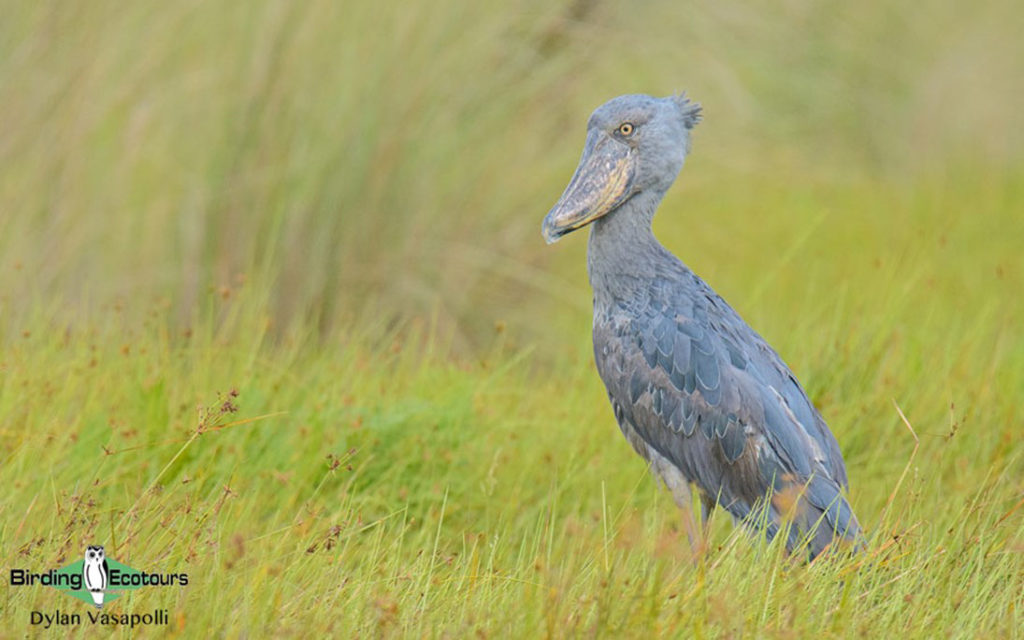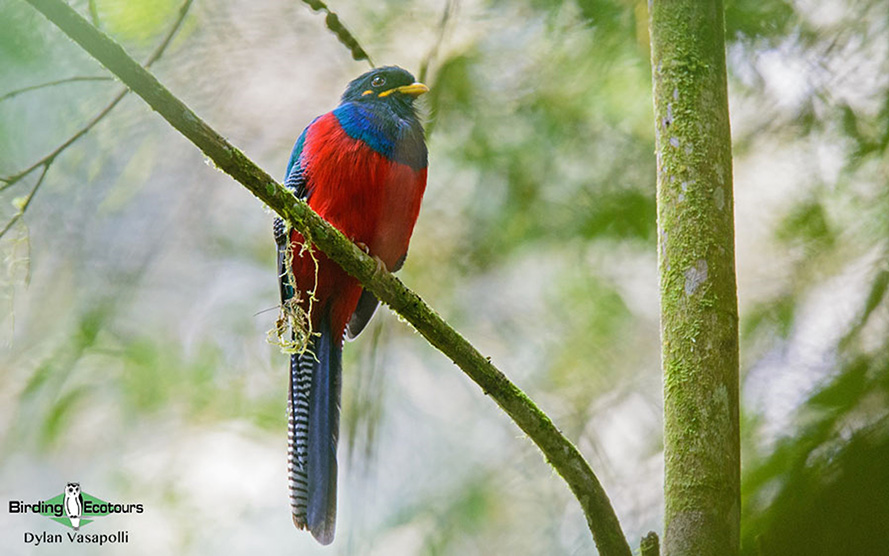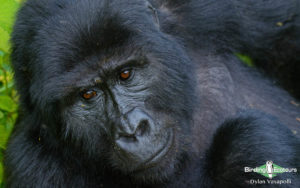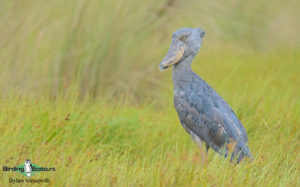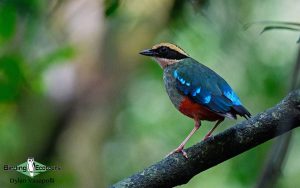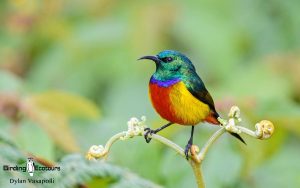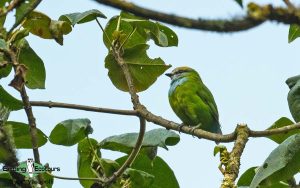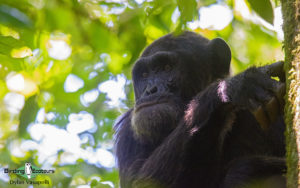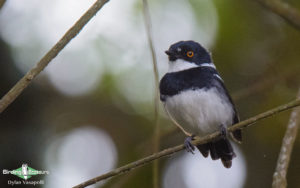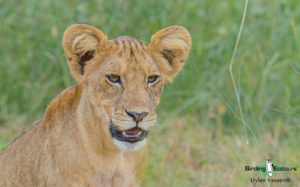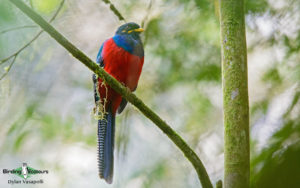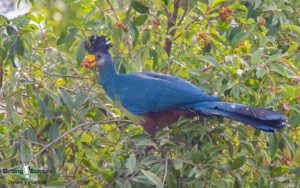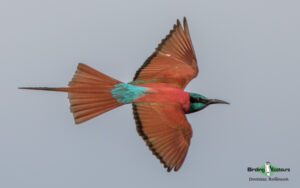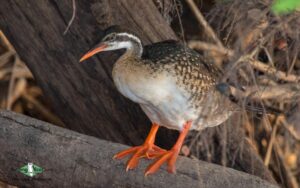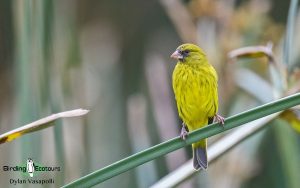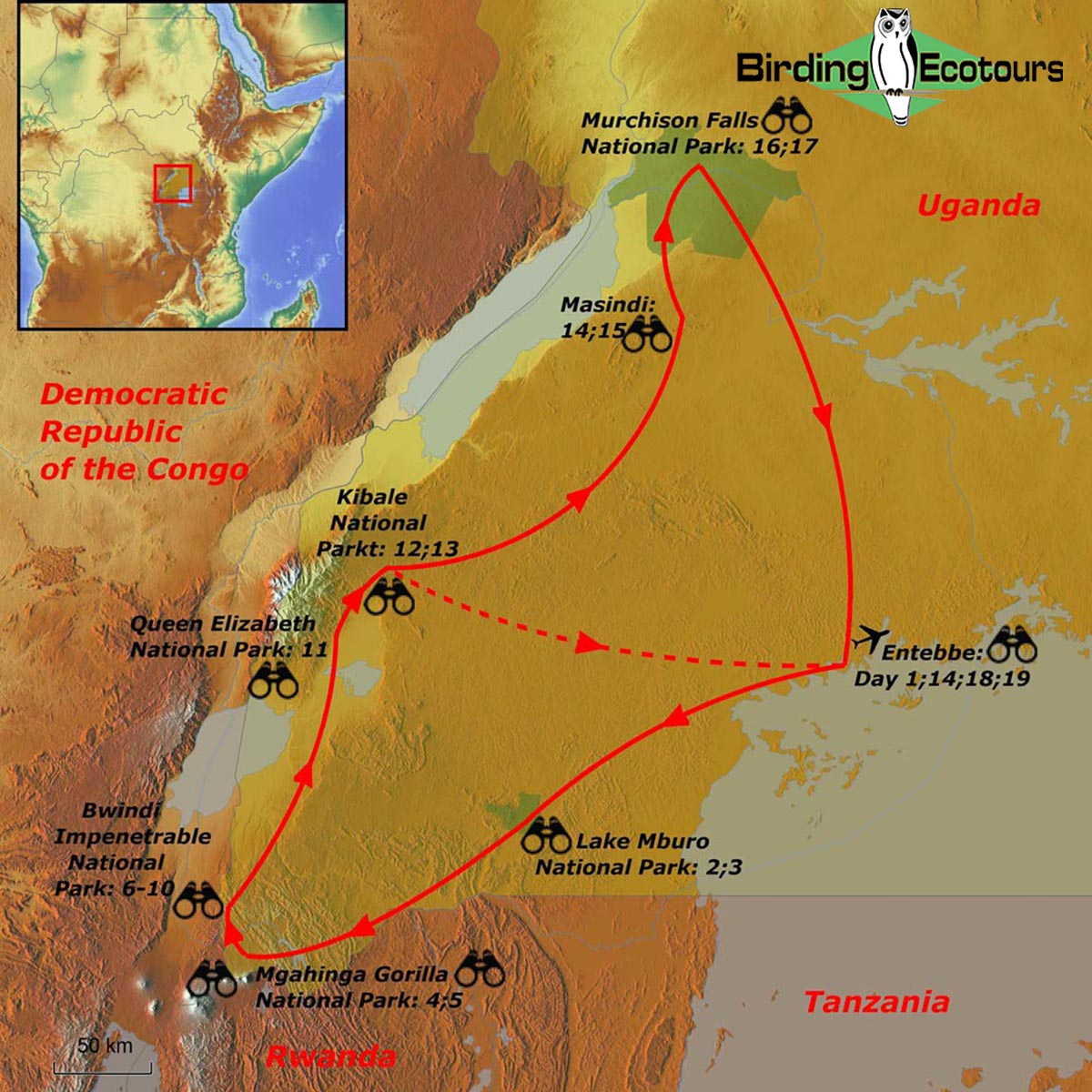Ultimate Uganda Birding Tour – Shoebill, Albertine Rift Endemics and Great Apes
Go to: Uganda Birding Tours | Birding Tours in Africa | All our birding tours
Ultimate Uganda Birding Tour – Shoebill, Albertine Rift Endemics and Great Apes
August 2025/2026
This Uganda birding and mammal extravaganza allows you to find the most important birds and primates that Uganda has to offer. Shoebill is almost guaranteed. Over 20 Albertine (Western) Rift endemics are also sought, including one of Africa’s most fabulous turacos, Rwenzori Turaco, and of course the “must-see” Grauer’s (African Green) Broadbill. We have not yet missed Green-breasted Pitta on any of our trips – Uganda has become the classic country for finding this otherwise very difficult bird. We also look for other range-restricted birds, such as Red-faced Barbet that is also found in a remote part of Tanzania excluded from most birding tours to that country. Ross’s Turaco, Great Blue Turaco (almost twice the size of other turacos), and various other birds are virtually garden birds here in Uganda, “the Pearl of Africa”. Other highlights of our Uganda birding tour are a great many primates such as Uganda Red Colobus, Guereza, Eastern (Mountain) Gorilla, and Chimpanzee, not to mention the spectacular scenery, including such famous places as Lake Victoria (the continent’s largest lake), Bwindi Impenetrable Forest National Park, and last but not least the Virunga Mountains.
Shoebill is one of the most sought-after birds in the world, and is one of our special targets on this tour!
The latter part of this tour is good for a host of more widespread African birds, Lion, with some luck Leopard, and fabulous sites such as Murchison Falls, where the mighty Nile is forced through a narrow gap.
We have the option to spend some time with Eastern (Mountain) Gorillas on this tour.
PLEASE NOTE: This trip is moderate in terms of fitness required, except for some days that are considered quite strenuous, such as the day of gorilla trekking and the day hike into Mubwindi Swamp and back. Chimpanzee trekking and looking for Green-breasted Pitta can also involve quite a lot of walking. You are welcome to opt out of any activities if you don’t feel you’ll manage them. There are also many days of forest birding; please wear appropriate clothing items (dark/neutral clothing and caps instead of very wide-brimmed hats) and be ready to spend good amounts of time on foot with a good chance of soaking rain, so protection for camera gear is advised.
Itinerary (19 days/18 nights)
Day 1. Arrival at Entebbe International Airport and birding the shore of Lake Victoria
We’ll fetch you from Entebbe International Airport and check in at our guest house before starting the birding. The dazzling Black-headed Gonolek as well as the striking Double-toothed Barbet are both common around Entebbe. Bat Hawk and African Hobby are sometimes seen around town. Broad-billed Roller, Palm-nut Vulture, numerous weavers, and perhaps our first Great Blue Turaco might be seen as we bird the Entebbe Botanical Garden on the edge of Africa’s largest lake.
Overnight: The Boma, or similar, Entebbe
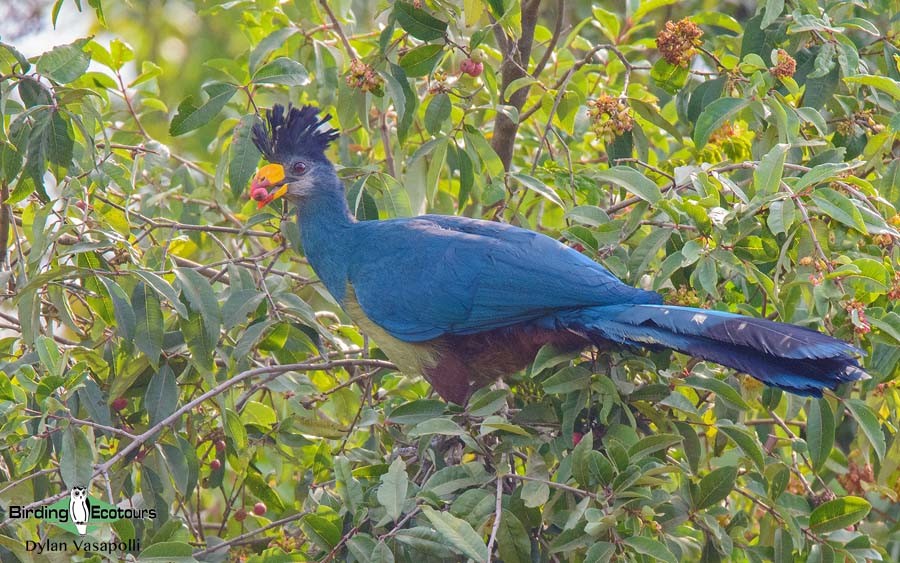
Days 2 – 3. Shoebill and transfer to Lake Mburo National Park
Bypassing the bustling city of Kampala (adjacent to the more pleasant small town of Entebbe) we head for Mabamba Swamp, one of Africa’s most accessible sites for the monstrous Shoebill. The papyrus-swamp-loving Red-chested Sunbird, numerous weaver species that build their impressively neat nests in the wetlands, coucals, and many tropical waterbirds such as Lesser Jacana abound as we do a dugout canoe trip into the huge swamp. Swamp Flycatcher is also common here. After seeing Shoebill we continue to our site for Orange Weaver, often seeing Eastern Plantain-eater, Ross’s Turaco, large flocks of the noisy Great Blue Turaco (the far-carrying calls of which are one of the characteristic sounds of Uganda), Grey Kestrel, and a very big, beautiful barbet, Double-toothed Barbet.
We eventually arrive at Lake Mburo National Park (where we’ll spend two nights), which breaks the journey between Entebbe and the southwestern border region of Uganda, where we will look for over 20 Albertine Rift endemics (this, also known as the Western Rift, is a branch of the Great Rift Valley).
The following morning we take a boat trip on the lake, and this is one of the easiest places to find African Finfoot. We sometimes see overwintering Malagasy Pond Heron and Papyrus Gonolek in addition to an array of kingfishers including the likes of Malachite Kingfisher, Giant Kingfisher, Pied Kingfisher, and the rare Shining-blue Kingfisher. In general this park gives us an excellent opportunity to see a lot of arid-country birds, which can include Blue-naped Mousebird, Bare-faced Go-away-bird, Golden-breasted Bunting, and the incredibly localized, rather “thin-on-the-ground” Red-faced Barbet, along with a more widespread East African species, Spot-flanked Barbet. Nubian Woodpecker is often heard before it is seen. Like in most arid-habitat parks in East Africa a large bird list can be accumulated very fast, and the above species are just a few of the many goodies we expect to find. This is the only place where we’re likely to see Plains Zebra during our Uganda birding tour, and there are a lot of other mammals as well, such as Hippopotamus, African Buffalo, Defassa Waterbuck, Bohor Reedbuck, Topi, Common Eland, and many more.
Overnight: Rwakobo Rock, Lake Mburo National Park
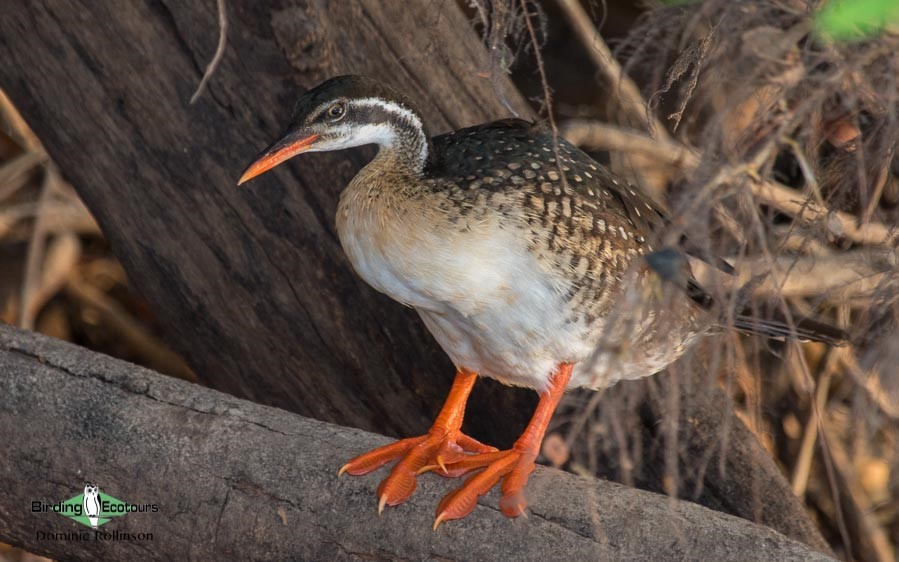
Days 4 – 5. Birding the Virunga Mountains region: Mgahinga Gorilla National Park
The Eastern (Mountain) Gorillas here freely roam into neighboring Rwanda and the DRC, but with extreme luck we might stumble across them (usually we have to wait until we get to Bwindi Impenetrable Forest National Park, though). One of the main reasons we include this park on our Uganda birding tour is to look for the gorgeous Rwenzori Turaco. This park has a lot of bamboo forest, in which we search for Abyssinian Ground Thrush. The very rare Shelley’s Crimsonwing is always possible – this Endangered (IUCN) species seems to be declining, and for once not because of humans. We may get a head start with some other Albertine Rift endemics, but most of these will have to wait for Bwindi.
Overnight: Travellers Rest, Kisoro
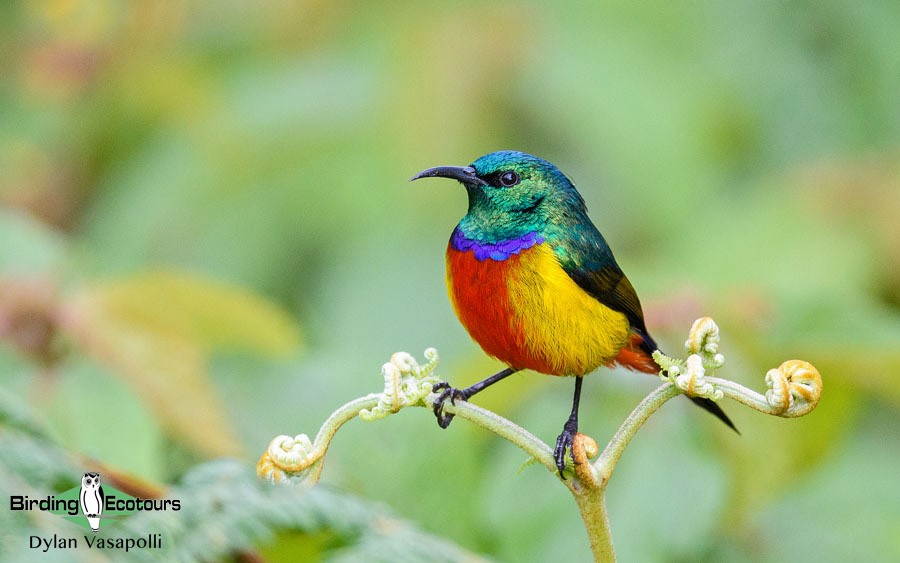
Days 6 – 7. Ruhija, Bwindi Impenetrable Forest National Park
We travel to one of Africa’s richest forests for primates and birds, Bwindi Impenetrable Forest National Park, and start in its high-altitude Ruhija part. We’ll start birding the forest-covered hills as soon as we arrive, looking for the beautiful Black Bee-eater and also trying to find Grauer’s Swamp Warbler at a roadside site, so that we can reduce the length of the long walk on day 6, this warbler occurring right in the lower reaches of Mubwindi Swamp. Mountain Yellow Warbler might also be seen, nice to compare with Papyrus Yellow Warbler, for which we try another day. A walk most of the way down to this swamp can’t be avoided, though, as Grauer’s (African Green) Broadbill, one of Africa’s most desirable birds, also occurs there.
The good-looking, highly localized Yellow-eyed Black Flycatcher also lurks pretty close to the bottom reaches. The walk down to the site for this broadbill (and back) takes a large part of the day, but this is one of the best birding days of the entire tour. Trip participants usually end up getting a constant stream of life-birds throughout the day, mainly Albertine Rift endemics. Banded Prinia, Mountain Masked Apalis, Rwenzori Apalis, Chestnut-throated Apalis, the strange-looking (and dull for a barbet) Grey-throated Barbet, Red-faced Woodland Warbler, and up to four species of quiet, brightly colored forest finches known as crimsonwings (all of them very difficult, though!) are often encountered. There are too many high-quality species to list here, but we hope to find Olive-breasted Greenbul (one of the more attractively colored greenbuls – we’ll see a great many of the duller ones, as Uganda is absolutely full of them, presenting quite an identification challenge). We do need to mention a couple of the other range-restricted species as well, though, – the very long-tailed Blue-headed Sunbird, the dazzling Regal Sunbird, Stripe-breasted Tit, Rwenzori Batis, and also slightly more widespread species like the fabulous Bar-tailed Trogon and Rwenzori Hill Babbler.
Overnight: Trekker’s Tavern Cottages, Ruhija
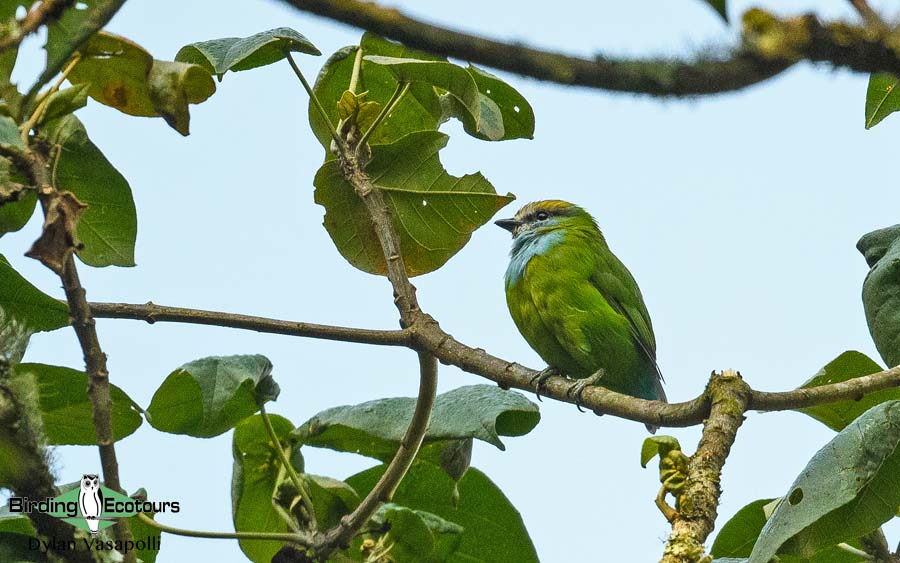
Days 8 – 10. Buhoma, Bwindi Impenetrable Forest National Park: birds and optional gorilla trekking
En route between the higher-altitude Ruhija and the lower-elevation Buhoma sections of the park we stop to bird “The Neck”, which allows us to see quite a number of species we won’t find elsewhere. Black Bee-eater and Cinnamon-chested Bee-eater are both quite easy to see here. Chubb’s Cisticola duets from the thickets. Black-and-white Shrike-flycatcher (also known as Vanga Flycatcher) might be seen – this charismatic bird usually moves around a lot (it’s an extremely lively species) and makes lots of noise as it flies around from one perch to the next. It has a fabulous crest, but the female is chestnut and white, whereas the male is black-and-white with striking yellow eyes. We might also see Brown-throated Wattle-eye, Mackinnon’s Shrike, Bronzy Sunbird and several other sunbirds, African Grey Woodpecker, Augur Buzzard, etc.
Deep-forest birds we’ll seek include many more localized endemics that barely get into neighboring countries – Grauer’s Warbler (not to be confused with Grauer’s Swamp Warbler, which we should have already seen), Bar-tailed Trogon, Petit’s Cuckooshrike, Lühder’s Bushshrike, Brown-capped Weaver and other weavers of the forest canopy, Red-throated Alethe, and lots of others. We’ll be sure to spend time looking for slightly more widespread birds as well, including the skulking White-spotted Flufftail, Red-shouldered Cuckooshrike, Olive-bellied Sunbird, some beautiful forest barbets such as the large Yellow-billed Barbet, the dazzlingly bright and shiny, green-and-yellow African Emerald Cuckoo, and, last but not least, Black-billed Turaco.
Forest-edge birding can be equally rewarding (and often easier for photography!) with such specials as Dusky Long-tailed Cuckoo, Great Blue and Ross’s Turaco, Grey-winged Robin-Chat, Black-necked Weaver, Red-headed Malimbe, Northern Double-collared Sunbird, Grey-headed Nigrita and many others. Over our two full days here we will spend plenty of time birding the forest trails, forest edge and adjacent agricultural areas.
At Buhoma itself, there is the opportunity for one day optionally trekking for Mountain Gorillas (this is a strenuous activity; if you decide not to join, you’ll be taken birding instead, or you can relax or look at and photograph birds around the lodge).
Overnight: Ride 4 a Woman, Buhoma
Bar-tailed Trogon occurs in the Bwindi Impenetrable Forest.
Day 11. Birds and mammals of Queen Elizabeth National Park
We stop over in Queen Elizabeth National Park (often staying on the Mweya peninsula itself, along the Kazinga Channel) en route to Kibale Forest. England’s queen officially opened this national park (well-known for its tree-climbing lions and boasting 100 mammal species and 600 bird species!) in 1954. One of the highlights of our stay here is getting out on the Kazinga Channel by boat and seeing Nile Crocodile, Hippopotamus, and a great many waterbirds. Naturally we also see Common Warthog, African Buffalo, Uganda Kob, and a plethora of other mammals. Forest Hog usually steals the show, however.
Overnight: Bushlodge, Queen Elizabeth National Park
Days 12 – 13. Kibale National Park – the Chimpanzee/Green-breasted Pitta combo
The drive from Queen Elizabeth to another fantastic national park, Kibale, is amazing: We traverse the foothills of the “Mountains of the Moon” (the Ruwenzori Range) and cross the equator, eventually arriving at the richest forest for primates on the African continent. Our main avian target is Green-breasted Pitta, which is best found at dawn, when its display call allows us to narrow down its whereabouts (otherwise, despite the jewel-like colors of this bird, it’s like looking for a needle in a haystack on the forest floor). While we search for this bird the atmospheric, quite scary noises of large troops of Chimpanzees resonate through the forest. There is also the opportunity for optionally trekking for Chimpanzees. We should also find some other primates such as L’Hoest’s Monkey, Uganda Red Colobus, one of the most striking of all African primates, Guereza (Eastern Black-and-white Colobus), Red-tailed Monkey, Grey-cheeked Mangabey, and other monkeys (not to mention the well-built Olive Baboon, which wanders around in massive groups, usually on the ground). We also have a lot of good birds to see, which might include White-headed Wood Hoopoe, Narrow-tailed Starling, Black-billed Turaco, and Chestnut Wattle-eye.
Overnight: Kibale Forest Lodge, Bigodi
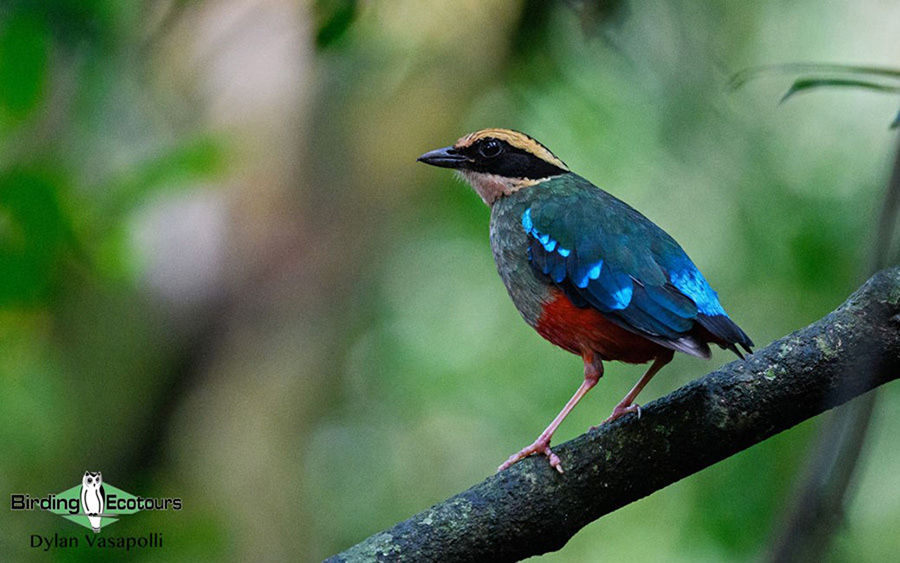
Day 14. Travel to Masindi
After some final birding around Kibale we head to Masindi. Time-permitting, we can already start birding famed sites nearby such as the Royal Mile.
Overnight: Masindi Hotel, Masindi
Day 15. Birding at Budongo Forest’s beautiful Royal Mile, transfer to Murchison Falls National Park
Budongo Forest is excellent for many special birds we won’t have yet seen during the tour. Chestnut-capped Flycatcher is a star bird – along with two other species: there is a trio of small warbler-like flycatchers that are taxonomically enigmatic, and this is one of them (we usually find the other two on our Tanzania and Mozambique birding tours). Fraser’s Forest Flycatcher is another prized bird here. But it’s the kingfishers (most of them not associated with water!) that make the Royal Mile famous. Chocolate-backed Kingfisher is probably the most popular of them all, but then Blue-breasted Kingfisher, African Dwarf Kingfisher, and others are also completely dazzling. Red-tailed Ant Thrush, Fire-crested Alethe, and Nahan’s Partridge usually stay close to the forest floor. The pretty Rufous-crowned Eremomela, White-thighed Hornbill, and a lot of others inhabit the canopy. Some fantastic forest barbets, tinkerbirds, and woodpeckers abound. There are a great many greenbuls, different species inhabiting different levels of the forest from the undergrowth to the canopy, and these are fun (or, in some people’s opinions, not!) to learn to identify. The Royal Mile is a breathtakingly beautiful forest to spend time in and certainly boasts an extremely rich birdlife. From here we will transfer to Murchison Falls National Park.
Overnight: Twiga Safari Lodge, near Murchison Falls National Park
Days 16 – 17. Murchison Falls National Park
We do boat trips and birding/game drives in this area, where we always add a great many new birds to our list. This is also a brilliant place for big and small mammals that might include Lion, Leopard, Rothschild’s Giraffe, Oribi, Lelwel Hartebeest, Common Warthog, the scarce Patas Monkey, and many others. Black-headed Lapwing, Silverbird, Speckle-fronted Weaver, Abyssinian Ground Hornbill, Red-throated Bee-eater, Swallow-tailed Bee-eater, Rock Pratincole, White-headed Barbet, Black-billed Barbet, Meyer’s Parrot, and Bateleur are just a few of the species on our rather large menu.
We should of course mention the fact that the massive volume of the Nile River is forced through a narrow gap here at Murchison Falls – while looking at this site there is a small chance that we might also manage to find Pel’s Fishing Owl or Bat Hawk. Where possible we can arrange night drives for some nightjar and owl species in the area; these may include Long-tailed, Plain, and Pennant-winged Nightjars and possibly Greyish Eagle-Owl.
Overnight: Twiga Safari Lodge, near Murchison Falls National Park
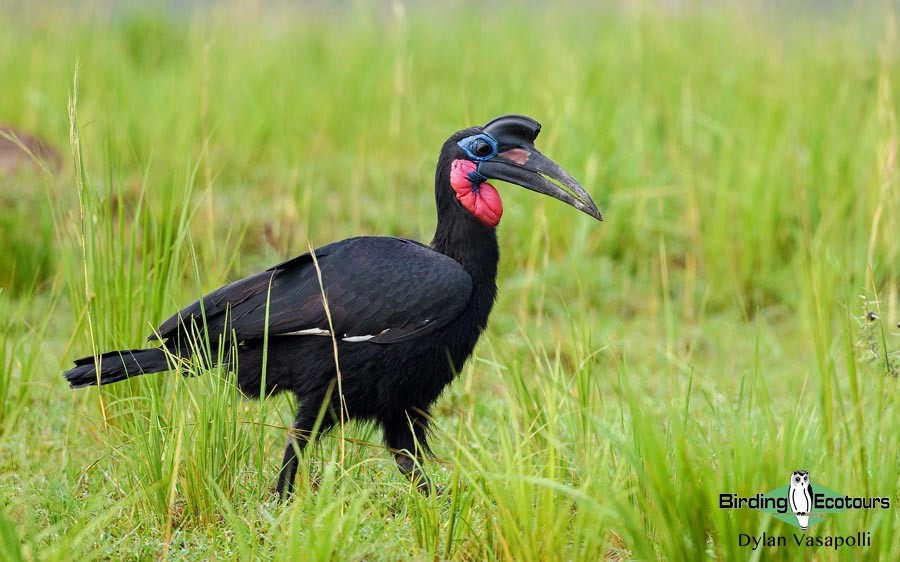
Day 18. Birding Kaniyo Pabidi Forest en route back to Entebbe
Today is mostly a travel day, however, we will enjoy a few birding stops on our way back to Entebbe. Our first birding will likely target Puvel’s Illadopsis at Kaniyo Pabidi Forest (the only known East African site for this rare forest dweller) as well as other lowland forest specials such as Western Crested Guineafowl, Spotted Greenbul, African Dwarf Kingfisher, Blue-breasted Kingfisher, Forest Robin and Yellow-mantled Weaver, amongst others. South of Masindi, we will make another stop in some grasslands to locate the localized Marsh Widowbird before we then transfer back to Entebbe.
Overnight: The Boma, or similar, Entebbe
Day 19. Flights leave Entebbe
Your flight can leave any time today from Entebbe International Airport.
Please note that the itinerary cannot be guaranteed as it is only a rough guide and can be changed (usually slightly) due to factors such as availability of accommodation, updated information on the state of accommodation, roads, or birding sites, the discretion of the guides and other factors. In addition, we sometimes have to use a different international guide from the one advertised due to tour scheduling.
Download ItineraryUltimate Uganda: Birding and Mammal Trip Report, July 2023
DOWNLOAD TRIP REPORT
10–29 JULY 2023
By Dominic Rollinson
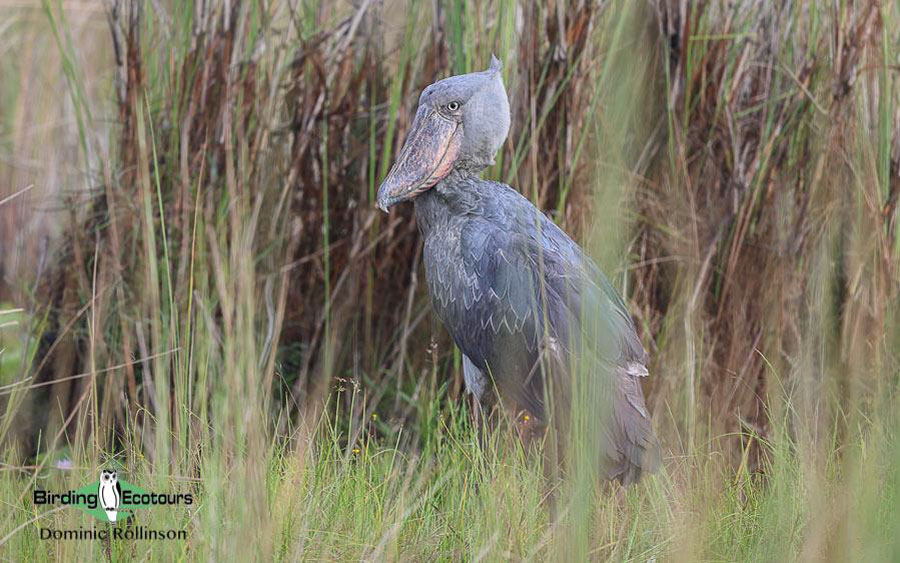
Shoebill was an early trip highlight and perhaps our most-wanted Ugandan bird target.
Overview
Our fixed departure Uganda birding tours offer you the opportunity of seeing a vast selection of East African bird species, including a whole host of Albertine Rift endemics, as well as many well-known and charismatic mammal species. Uganda is known amongst birders as perhaps the most accessible country to find two iconic bird species; the massive and bizarre-looking Shoebill and the enigmatic Green-breasted Pitta, both of which were seen well on this tour. Our 19-day Uganda birding tour covers the ‘traditional’ birding route through the western half of the country and adds on some lesser-visited spots, such as Mgahinga Gorilla National Park, right in the southwestern corner of Uganda, on the border with Rwanda and the Democratic Republic of Congo (DRC). This tour was scheduled during Uganda’s dry season, when inclement weather generally does not play a role, and to coincide with the peak breeding season of many of our special targets.

Green-breasted Pitta put on an exceptional show for us at Kibale Forest.
Despite this being our set departure tour, we were able to run it with just two clients, David and Barbara, which meant it could essentially be run as a private tour, occasionally opting out of certain strenuous hikes etc. This meant we missed a few Albertine Rift Endemics and other specials by excluding the Mubwindi Swamp walk, however, the birding was exceptional throughout the trip, and we amassed a list of 534 species.
This tour started in Entebbe, before we moved to the shores of Lake Victoria at Mabamba Swamp, where we had special views of the most-wanted bird of the trip, Shoebill. We then pressed on southwest to Lake Mburo National Park, where we spent two days birding the dry woodlands, with highlights including Red-faced Barbet, and enjoyed a boat cruise on Lake Mburo, which saw us adding African Finfoot and White-backed Night Heron. Next, was a long transit to the southwest corner of the country, where we had a full day’s birding in the Mgahinga Gorilla National Park and found our two main targets of the area; Rwenzori Turaco and Rwenzori Double-collared Sunbird, as well as a pair of the tricky White-collared Oliveback.
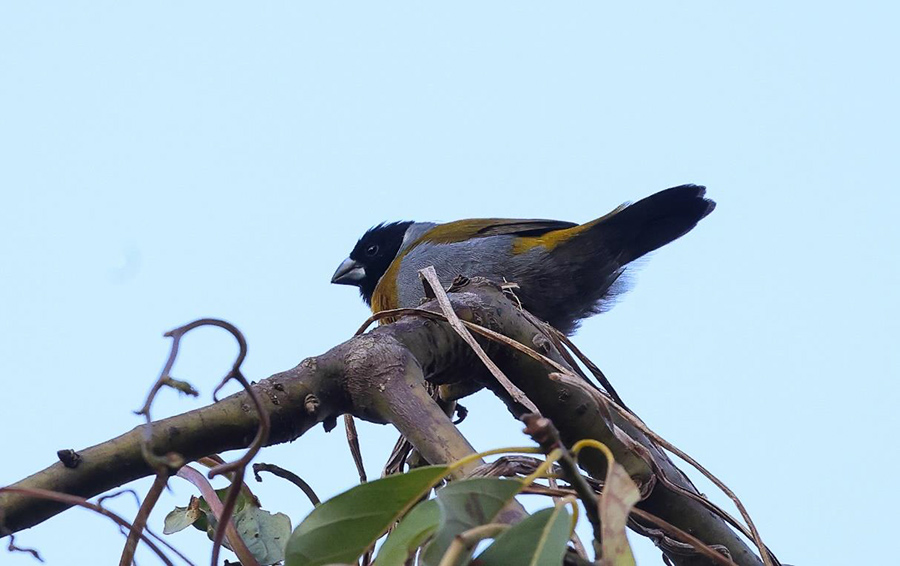
This male White-collared Oliveback was seen in Kisoro.
The famous Bwindi Impenetrable Forest was up next, where we spent five nights and enjoyed a lot of forest birding and, of course, Eastern (Mountain) Gorillas. The highlands of the Ruhija section were particularly birdy, and we found such targets as Dusky Crimsonwing, Grauer’s Warbler and Stripe-breasted Tit. We spent a few hours birding The Neck en route to the lower forests of Buhoma, which added Bar-tailed Trogon and many other new bird species, before we spent three nights birding at Buhoma. Barbara had a fantastic experience on her gorilla trekking, and the general forest birding was again excellent, with a whole host of forest species enjoyed here.
We then briefly left the Ugandan forests behind for a couple of days, birding the savannas and river channels of Queen Elizabeth National Park. This again resulted in a huge jump in our trip list, and we also enjoyed seeing Lion and Leopard while in the park.
It was soon back into the forests as we entered Kibale National Park, where we had a magical 20 minutes watching a displaying Green-breasted Pitta and bumped into some feeding Chimpanzees while enjoying the forest’s many bird specials.
After a long transfer further north, we spent the morning birding Budongo Forest’s famous Royal Mile. It was its usual birdy self with Fraser’s Forest Flycatcher, Chestnut-capped Flycatcher and African Dwarf and Chocolate-backed Kingfishers all seen well, with the neighboring farmlands producing Brown Twinspot and stunning views of Grey-headed Oliveback.
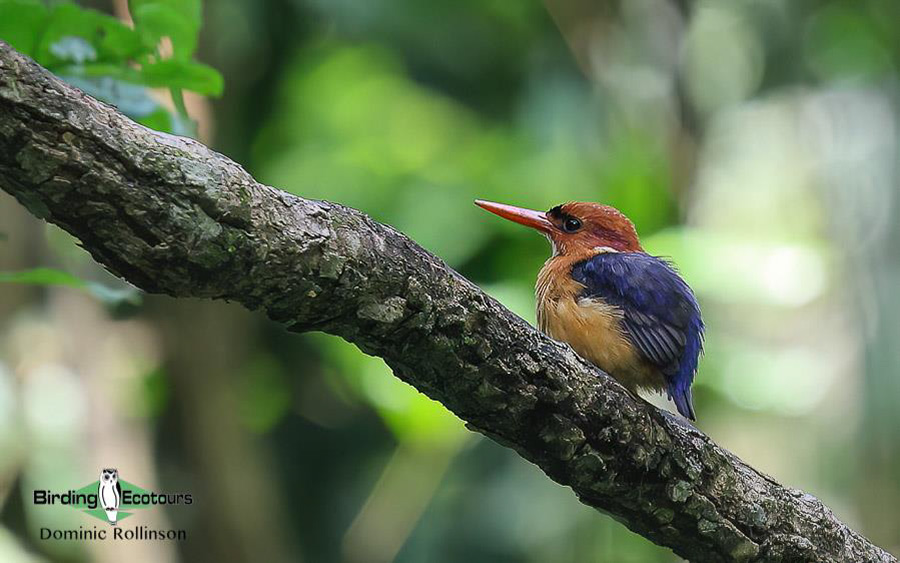
African Dwarf Kingfisher showed incredibly well in Budongo Forest.
Finally, we spent three nights in Murchison Falls National Park, where we saw a plethora of new wildlife and some standout species such as White-crested Turaco, Dusky Babbler and Pennant-winged Nightjar. It was then time to make our way back south towards Entebbe, with some final birding in Kaniyo Pabidi Forest and Ziwa Rhino Sanctuary before making our way back into Entebbe where the tour ended.
Detailed Report
Day 1, 11th July 2023. Entebbe birding
With all of us having arrived the afternoon before, we decided to get an early start to our birding with a walk around Entebbe’s very birdy suburbs and managed to find a heap of birds to get our Uganda bird list rolling. Some of the highlights of our pre-breakfast walk included African Hobby, Shikra, Ross’s Turaco, Eastern Plantain-eater, Crowned and Black-and-white-casqued Hornbills, Woodland Kingfisher, Broad-billed Roller, Grey Parrot, Black-headed Gonolek, Green-headed and Red-chested Sunbirds and a small group of Piapiacs. As we were enjoying breakfast, David spotted a pair of Palm-nut Vultures, which posed nicely for us.
After lunch, we met William, our driver and expert guide for the trip, and headed to the lovely Entebbe Botanical Garden on the shores of Lake Victoria, which always provides a fantastic start to our Uganda birding tour. Before reaching the botanical garden, we stopped at a nearby Bat Hawk roost, which was unfortunately empty, however, we did find a pair of roosting Southern White-faced Owls, which was an unexpected bonus. The botanical garden was alive with birds and we soon notched up Lizard Buzzard, Blue-spotted Wood Dove, the huge Great Blue Turaco, African Pygmy Kingfisher, Olive (Madagascar) Bee-eater, African Hobby, Grey Parrot, Green Crombec, Grey-capped Warbler, Winding Cisticola, Olive-bellied Sunbird and Orange and Golden-backed Weavers. After dipping on Bat Hawk earlier, we soon made up for this miss when we found a pair of roosting birds high up in the tree canopy. The lakeside was also full of birds, with Pink-backed Pelican, Hamerkop, Striated Heron and Pied Kingfisher all seen well. After an incredibly productive first day, with all our targets found, we enjoyed cold beers and a meal at our hotel before retiring for the evening, all excited about the prospect of Shoebills the next morning!
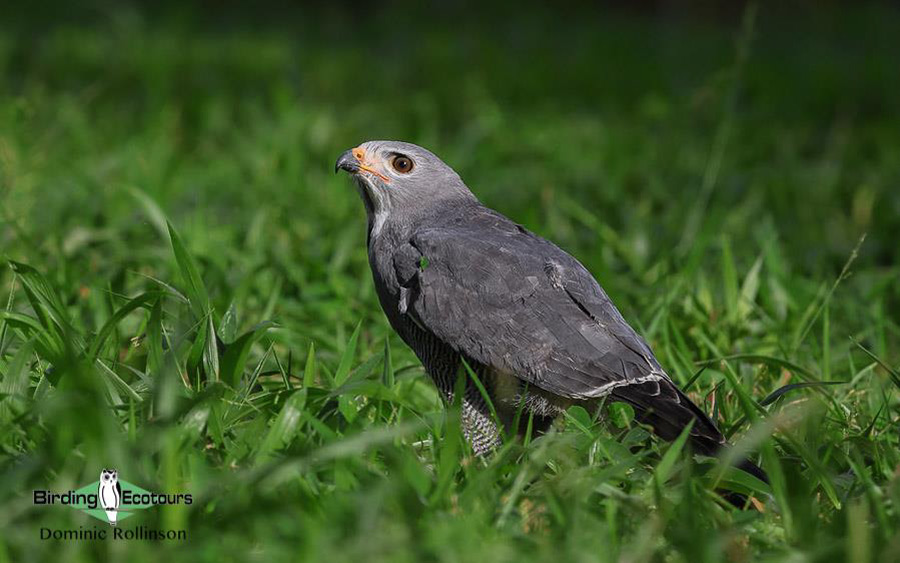
This confiding Lizard Buzzard was seen in the Entebbe Botanical Garden.
Day 2, 12th July 2023. Mabamba Swamp and transfer to Lake Mburo
An early start this morning as we made our way west towards Mabamba Swamp, where we would enjoy a boat trip to look for Shoebill. On our way out of Entebbe, David delighted in seeing Marabou Storks perched on top of buildings, immediately adding to the beauty of the building – beauty is in the eye of the beholder! We soon boarded our motorized dugout canoes and made our way through the swamp’s network of channels. It took a little while, but eventually, news filtered through that a Shoebill had been found nearby, and we shot by and were able to enjoy the bird for ten minutes all by ourselves before other tourist boats arrived on the scene, and it got a bit chaotic. David’s main target bird of the trip was in the bag on the first morning of the trip, with some fantastic views enjoyed by us all!
Of course, the general birding while out on the boat was productive too, and we also added the likes of Long-toed Lapwing, Blue-headed Coucal, African Swamphen, White-winged Tern, Purple and Squacco Herons, Great Egret, African Marsh Harrier, Blue-breasted Bee-eater, Banded and Brown-throated Martins, Red-breasted Swallow, Swamp Flycatcher and Northern Brown-throated Weaver. After our boat ride, we birded some woodland on the edge of the swamp, where we found African Blue Flycatcher, Brown-throated Wattle-eye, Copper Sunbird and Brimstone Canary.
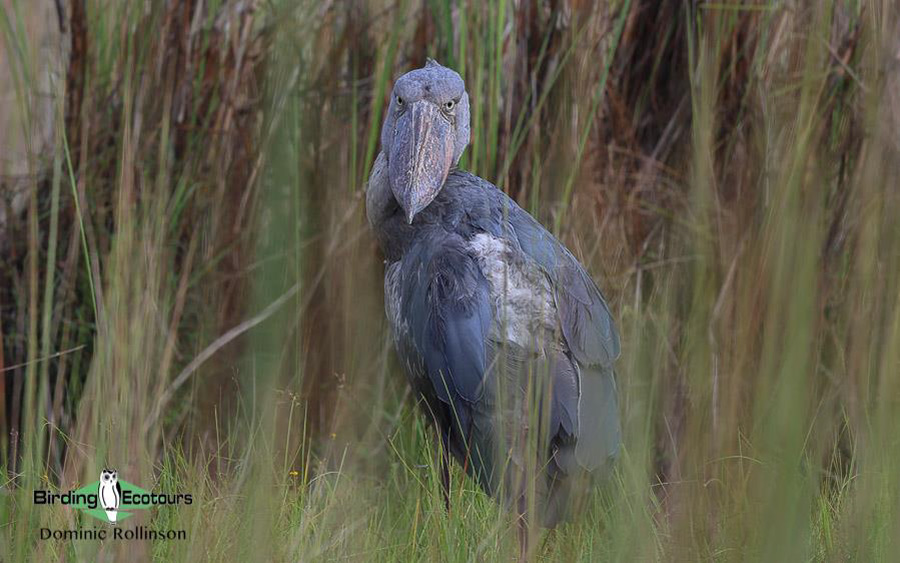
The huge and fierce-looking Shoebill was seen in Mabamba Swamp.
It was then time to get moving, as we still had some more birding to do before our lunch stop. We stopped on the edge of the nearby Mpanga Forestry Reserve, where we had flyover Palm-nut and Hooded Vultures and African Harrier-Hawk and were made to work for Weyn’s Weaver, which eventually showed, albeit briefly. Other birds seen in the area included African Pied and Crowned Hornbills, Black Cuckooshrike, Plain-backed Pipit and Tawny-flanked Prinia.
We stopped for a traditional lunch at the equator before the long haul southwest towards Lake Mburo National Park, where we would be based for the next two nights. The drive was mostly uneventful, however, we did add a few new trip birds, such as Lilac-breasted Roller, Long-crested Eagle, Speckled Pigeon and Black-chested Snake Eagle.
Late in the afternoon, we made it onto the dirt road to Lake Mburo, which is always incredibly birdy and thus normally takes a long time to negotiate. Today was no different, and we spent a good couple of hours working these farmlands and open woodlands. New birds came thick and fast and included the likes of Crested Francolin, Brown-chested Lapwing (one of the big targets of the area), Black-winged Kite, Blue-naped Mousebird, Little Bee-eater, Spot-flanked Barbet, Meyer’s Parrot, Grey (African) Penduline Tit, Red-faced Crombec, Trilling Cisticola, White-browed Scrub Robin, and a few cute Black-faced Waxbills. Verreaux’s Eagle-Owl, starting its night out a little early today, was a welcome surprise to cap off the day. We then settled into our lovely accommodation with Freckled Nightjar heard calling as we enjoyed a tasty dinner that evening.
Day 3, 13th July 2023. Lake Mburo National Park birding and boat cruise
After an early breakfast, we were in our land cruiser and on the way to Lake Mburo National Park, where we birded for the entire morning. The farmland and degraded woodland en route to the park was a little quieter than usual, however, we did manage to find Bare-faced Go-away-bird, White-browed Coucal, White-winged Black Tit, Long-tailed Cisticola, Arrow-marked and Black-lored Babblers and Marico Sunbird.
The entrance gate to Lake Mburo National Park was its usual birdy self, and we soon found our target bird, Red-faced Barbet, which was seemingly part of a mixed-species pair as it was displaying with the similar Black-collared Barbet. Other good birds seen here included Snowy-crowned Robin-Chat, Common Scimitarbill, Lesser Masked Weaver and Green-winged Pytilia, with Red-headed Lovebirds seen noisily flying overhead. We also enjoyed our first views of large game, including Plains Zebra, Common Warthog, African Buffalo, Bushbuck, Common Eland, Impala, Waterbuck, Topi and Giraffe.
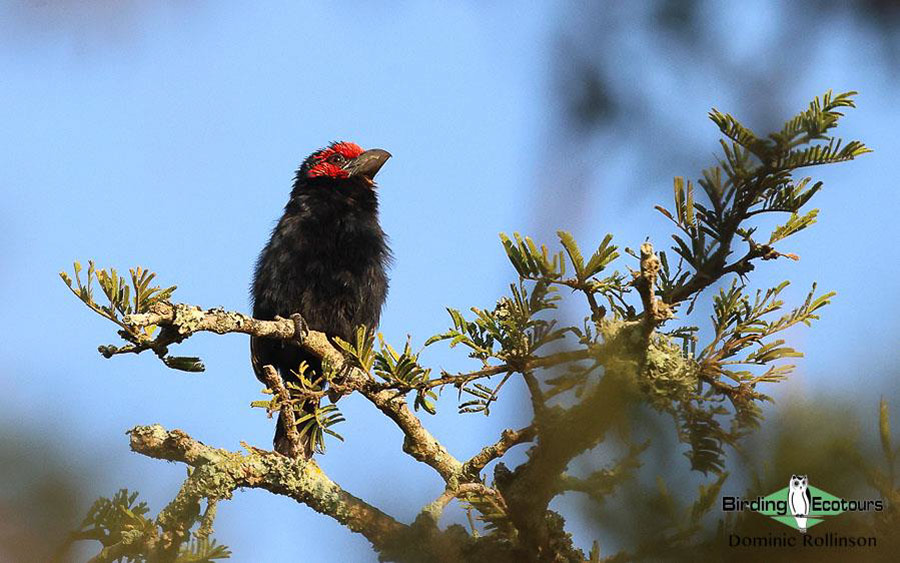
This Red-faced Barbet was seen at Lake Mburo National Park.
We then took a very slow drive through the productive woodlands where the birding was exceptional. We came across many feeding flocks, and slowly working through them gave us a multitude of new birds. Our long list of highlights from within Lake Mburo National Park included Red-chested Cuckoo, Green Wood Hoopoe, Grey-headed and Striped Kingfishers, Crested Barbet (a range-restricted species in southwestern Uganda), White-headed Barbet, Cardinal, African Grey and Nubian Woodpeckers, Meyer’s Parrot, Black Cuckooshrike, Chinspot Batis, Orange-breasted Bushshrike, White-winged Black Tit, Grey Penduline Tit, Red-faced Crombec, Green-capped Eremomela, Greater Blue-eared Starling and many others. Several raptor species were seen throughout the morning and included White-backed Vulture, Bateleur, Wahlberg’s Eagle and Grey Kestrel. We enjoyed watching a small group of Senegal Lapwings feeding in a recently burnt field, along with a pair of African Wattled Lapwings. After a long and successful morning’s birding, we headed back to our lodge for lunch and then took a couple of hours off in the heat of the early afternoon.
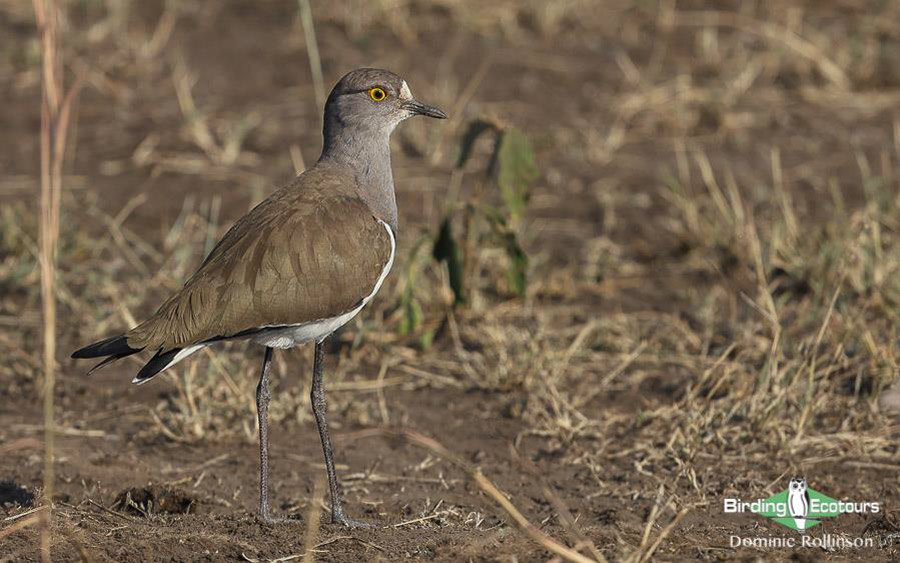
Senegal Lapwings were seen in open areas in Lake Mburo National Park.
Later that afternoon, we made our way back into the national park and headed towards Lake Mburo itself for our much-anticipated boat trip. We again took our time driving through the park and saw more of the regulars, including Crested Francolin, Red-necked Spurfowl, African Openbill (the same bird we saw earlier in the day at its puddle), Lilac-breasted Roller, Black-headed Oriole, Tropical Boubou and Lesser Masked Weaver. We arrived in the late afternoon for our boat ride, which took less than five minutes for us to find our primary target, African Finfoot. The initial sighting of this bird was brief, but over the course of the next two hours, we had multiple prolonged sightings of this unusual bird. Another big target of the boat cruise was White-backed Night Heron which we too found on this trip. It took a lot of maneuvering of the boat from the skipper and changing of our angles, but we eventually all had seen enough to piece the birds together. Other common waterbirds included Black Crake, Water Thick-knee, Hamerkop, Common Sandpiper, Striated Heron and Malachite and Pied Kingfishers. At the same time, a couple of large flocks of Splendid Starlings further kept us entertained. We drove out through the park as the sun was setting and managed flight views of Swamp Nightjar while Fiery-necked Nightjar and African Scops Owl would make it onto the heard-only list for now.
Day 4, 14th July 2023. Lake Mburo to Kisoro, birding en route
We had an early breakfast and then enjoyed a casual walk around the lodge grounds, where we hoped to find Striped Pipit. The pipit would not show, however, we did find large flocks of Splendid Starlings and African Green Pigeons feeding in a large fig tree and also saw Brown-throated Wattle-eye, African Paradise Flycatcher, Yellow-throated Leaflove and Green-headed Sunbird in the general area.
We then packed the vehicle and were soon on our way, with a quick stop for Slate-colored Boubou as we left the area, which also produced African Hoopoe and our first looks at House Sparrow (which caused much excitement). On our way out of the Lake Mburo area, we stopped at a wetland which was just alive with birds and we did not know which way to look. In no time at all, we had added Grey Crowned Crane, African Openbill, Little Bittern, Rufous-bellied Heron, Glossy Ibis, African Marsh Harrier, Greater Swamp Warbler, Highland Rush Warbler and even managed views of a couple of skulking African Rails. In the nearby fields, we found a few more Brown-chested Lapwings and Fan-tailed Widowbirds. We made one final stop at a small dam for White-backed Ducks, which showed well before we hit the long road towards Kisoro, right in the southwest of the country.
We had a late lunch stop on the edge of Lake Bunyonyi, where we enjoyed good looks at Bronzy Sunbird, White-browed Robin-Chat, Black-crowned Waxbill and Western Citril before we moved onto Echuya Forest Reserve. Despite the heat of the early afternoon, Echuya was its usual birdy self and a couple of hours birding here produced Cinnamon-chested Bee-eater, White-browed Crombec, Chubb’s Cisticola, Rwenzori Hill Babbler, Sharpe’s Starling, Dusky-blue Flycatcher, Northern Double-collared Sunbird, Red-headed Malimbe and our first Albertine Rift endemics in the form of Regal Sunbird, Rwenzori (Collared) Apalis and brief views of Strange Weaver.

Regal Sunbird, a stunning Albertine Rift endemic.
After a long day on the road, we made it to our lovely accommodation just outside of Kisoro, which is beautifully set alongside a stream and makes for a tranquil atmosphere, with plenty of exciting birds around.
Day 5, 15th July 2023. Mgahinga Gorilla National Park birding
Today was another exciting day as we spent a large portion of the day in Mgahinga Gorilla National Park and hiked up the slopes of Mount Sabyinyo in search of a few localized specials. The 12,000-foot (c. 3,700 meter) Mount Sabyinyo is an extinct volcano (one of three impressive extinct volcanoes in the area) which falls on the border of Rwanda, the DRC and Uganda. It is found within three separate parks in these different countries, Virunga National Park in the DRC, Volcanoes National Park in Rwanda and Mgahinga Gorilla National Park in Uganda. We had most of the day to slowly hike up the slopes, with Rwenzori Turaco and Rwenzori Double-collared Sunbird being our two primary targets.
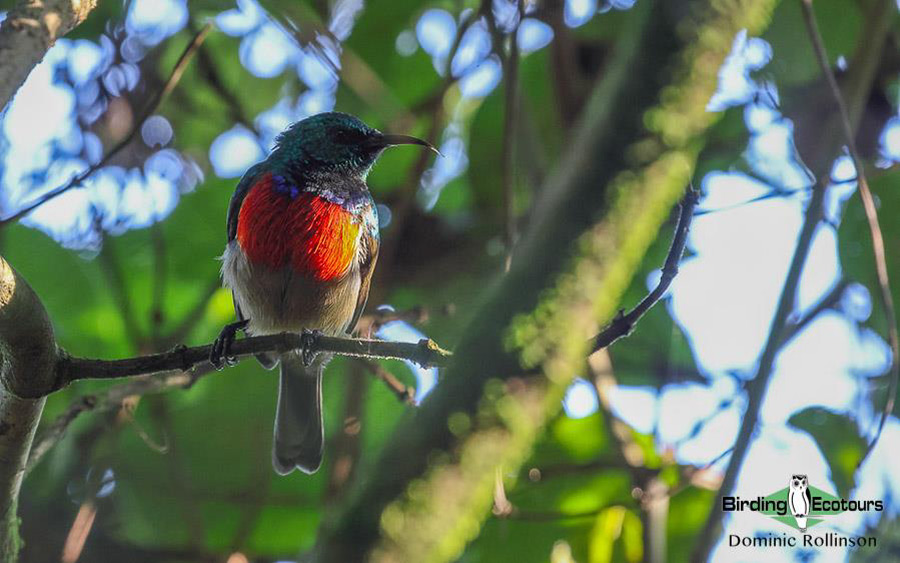
Rwenzori Double-collared Sunbird was seen well on the slopes of Mount Sabyinyo.
After arriving in the park, we soon set out for our hike with our local guide, Patrick, and a couple of armed park rangers. It did not take long at all to find Rwenzori Double-collared Sunbird, which showed well, and we noted its heavier bill and longer tail, which differentiates it from the similar Northern Double-collared Sunbird. Other species seen on the initial stretches of the trail included Dusky Turtle Dove, Cinnamon-chested Bee-eater, Rwenzori Batis, Cinnamon Bracken Warbler, Northern Puffback, Mountain Masked and Chestnut-throated Apalises, Yellow-whiskered and Olive-breasted Greenbuls, Red-faced Woodland Warbler, Rwenzori Hill Babbler, White-starred Robin and Streaky Seedeater. We heard the high-pitched calls of Dusky Crimsonwing; however, we could not see any of these little beauties (yet). Heading further up the slopes, we added the likes of Levaillant’s Cuckoo, Western Tinkerbird, Mountain Yellow Warbler, White-eyed Slaty Flycatcher and a large flock of Kandt’s Waxbills. After much work, we eventually managed to get good views of Albertine Sooty Boubou, which we had been hearing for most of the morning. We only managed brief views of the vocal and elusive Doherty’s Bushshrike and would have to wait a little longer for better views of this stunning species.
We eventually made it to our turnaround point, where we enjoyed a well-earned break in the shade and tucked into our lunch packs. We then ventured a little further into the bamboo section, which was very quiet, and so decided to start slowly making our way back down. We had yet to see (or even hear) Rwenzori Turaco, and just as a bit of dipping dread was starting to creep in, we heard a bird call from relatively close by. After a bit of work, we eventually managed to see a pair of these strange-looking turacos as they bounced around the trees and did a couple of flybys showing their brilliant red wings, which is due to the presence of the pigment, turacin (after which turacos get their name and which is only found in this bird family).
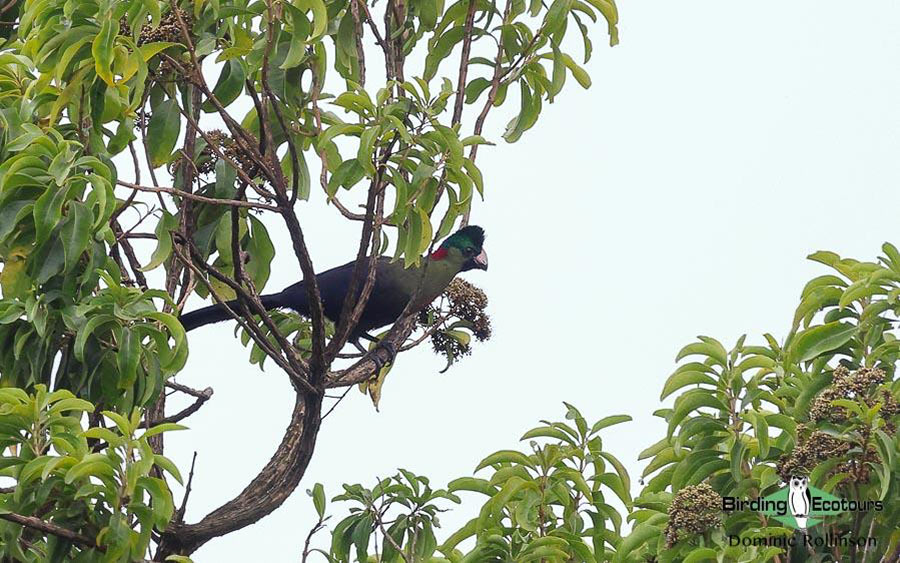
The unusual Rwenzori Turaco took some effort to find.
After seeing the turaco, we could relax a bit and concentrate on some of the many other birds around, including a small flock of Scarce Swift, brief views of a White-tailed Crested Flycatcher and right at the end of the walk, a calling Dwarf Honeyguide (well picked up on, William) which is a very difficult Albertine Rift endemic.
After a long day out, we decided to put our feet up back at our lodge and just enjoy our surroundings. However, we had a few birding distractions while we were relaxing and managed some lovely views of the striking but scarce White-collared Oliveback as well as a flyover African Spoonbill and Yellow-billed Stork. The day ended wonderfully well when we found a calling Western Barn Owl in the lodge grounds later that evening.
Day 6, 16th July 2023. Kisoro to Ruhija, papyrus birding en route
We ate breakfast just before dawn this morning and were soon out the door as we were transferring to the Ruhija section of Bwindi Impenetrable Forest, with some fine birding stops scheduled en route. Our first stop was on a winding road overlooking a lake where we added Red-knobbed Coot and a few Red-rumped Swallows lazily flying overhead. We then excitedly made our way back into Echuya Forest, this time at a much better time of the day, and soon started finding some of our missing targets. We yet again had brief views of Strange Weaver (they unfortunately would just not sit still!) along with African Olive Pigeon, Grey Cuckooshrike, Mountain Oriole and the best of the lot, prolonged views of a calling Barred Long-tailed Cuckoo.
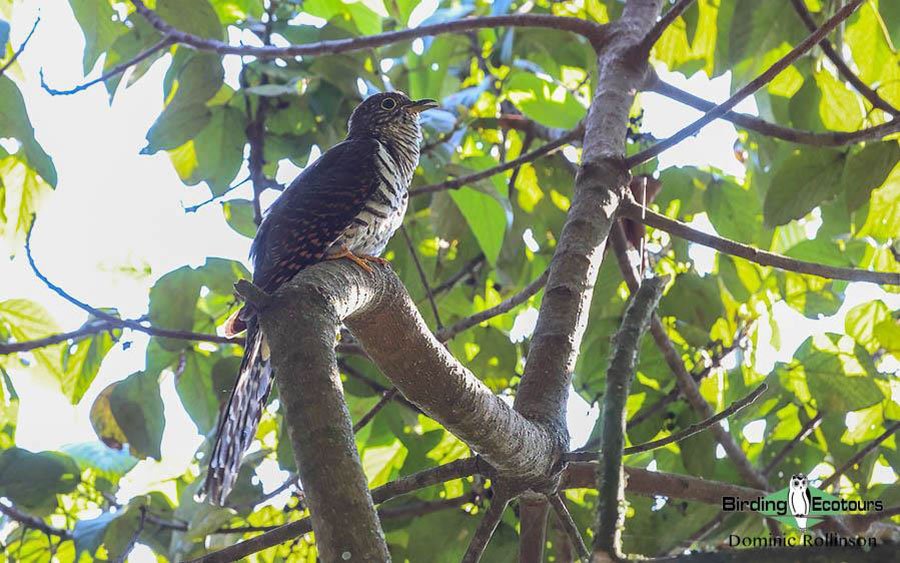
Barred Long-tailed Cuckoo seen in Echuya Forest.
It was then time for a quick break from forest birding as we made our way to the edge of Lake Bunyonyi to try for a few swamp specials. Papyrus Yellow Warbler proved remarkably easy and showed up without much of a wait, with Mackinnon’s Shrike and Carruthers’s Cisticola showing well too, while Black-and-white Mannikin made a brief flyby. We tried for Red-chested Flufftail, and although we saw some grass move and heard a call response, we could not lay eyes on these notorious skulkers.
Next, it was time to target Papyrus Canary in a nearby swampy area on the edge of some millet fields. We spent a lot of time working through flocks of Western Citril as well as Black-and-white Mannikin, Black-crowned and Common Waxbills and an assortment of weavers, including Black-headed, Northern Brown-throated and Slender-billed Weavers. After a while, Barabara spotted a pair of canaries sitting up in the papyrus, which turned out to be our primary target, Papyrus Canary. We also enjoyed watching Augur Buzzard and Wahlberg’s Eagle as they soared above us. We then enjoyed our lunch on the edge of Lake Bunyonyi, with many Red-chested and Bronzy Sunbirds around as happy distractions.
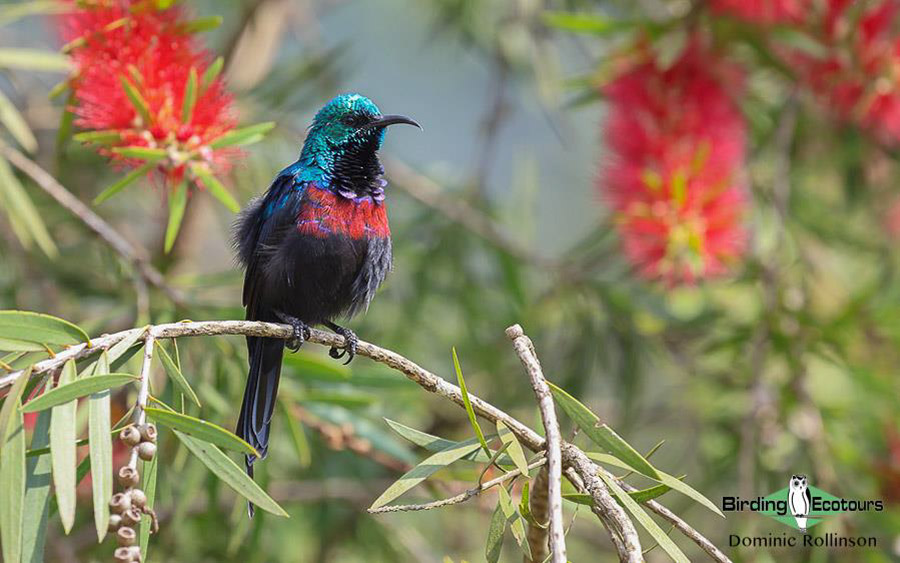
Red-chested Sunbirds were common throughout this tour.
After lunch, it was time to move on to the Ruhija section of the famous Bwindi Impenetrable Forest. The drive across was uneventful, and after arriving in Ruhija, we took some time off in the early afternoon before our late afternoon’s birding outing.
After meeting up with our eagle-eyed local guide, Gordon, we decided to spend some time birding the farmlands just outside of Ruhija, targeting Dusky Twinspot. Despite some focused searching, we could not find the twinspots, however, we did come across some other good bird species, such as Red-rumped Swallow, African Stonechat, Variable Sunbird, Streaky Seedeater, Yellow-crowned Canary and a juvenile Rufous-chested Sparrowhawk (well spotted Barbara!). We then birded some nearby patches of forest where we found Great Blue Turaco, Western Tinkerbird, Northern Double-collared Sunbird and best of all, a very showy Doherty’s Bushshrike which sat preening in the sun for us. We also saw a few Carruther’s Mountain Squirrels while birding in the forests. We then took a drive towards the bamboo section of Bwindi in the hopes of finding the tricky Handsome Spurfowl, which unfortunately would not oblige for us.
Day 7, 17th July 2023. Birding the highlands of Ruhija
Today would normally have been the day we undertake the long trek down to Mubwindi Swamp to look for Grauer’s Broadbill and Grauer’s Swamp Warbler; however, due to the difficulty of the walk, we decided to rather just bird the roadside and farmlands for the day. We were keen for another shot at Dusky Twinspot, and this time, the birds showed well within 15 minutes of arriving at the site, and we also found Slender-billed Starling and Lanner Falcon in the area.
We then birded a section of forest along the main road near Ruhija, which proved very productive, and we found many of our targets. Standout species included Yellow-billed and Grey-throated Barbets, White-tailed Blue Flycatcher, Black-throated and Mountain Masked Apalises, Mountain Yellow Warbler, Red-faced Woodland Warbler, Waller’s Starling, Abyssinian Thrush, Blue-headed and Regal Sunbirds and Thick-billed Seedeater. We tried a few favored spots for the gorgeous Dusky Crimsonwing, but this species continued to elude us.
After lunch and a short break, it was time to bird the famous Ruhija school track, which again proved incredibly productive. After Gordon’s morning in Mubwindi Swamp, we were happy to have him join us again and were thoroughly impressed by his knowledge of calls and ability to pick out any bird movement. First up was Stripe-breasted Tit (an Albertine Rift endemic), which was soon followed by a pair of Equatorial Akalats which showed surprisingly well in the dark undergrowth. We kept hearing the secretive Grauer’s Warbler, but unfortunately, it would not show for us today; the loud and colorful Black-billed Turaco, however, put on a fantastic show for us. Over the next couple of hours, we managed to get views of a great many forest species, including African Olive Pigeon, Cinnamon-chested Bee-eater, Rwenzori Batis, Lühder’s Bushshrike, White-chinned Prinia, Rwenzori and Mountain Masked Apalises, Yellow-streaked Greenbul, Mountain Illadopsis and Regal Sunbird. We heard Red-headed Bluebill, but despite our best efforts, we could not lay eyes on this attractive finch.
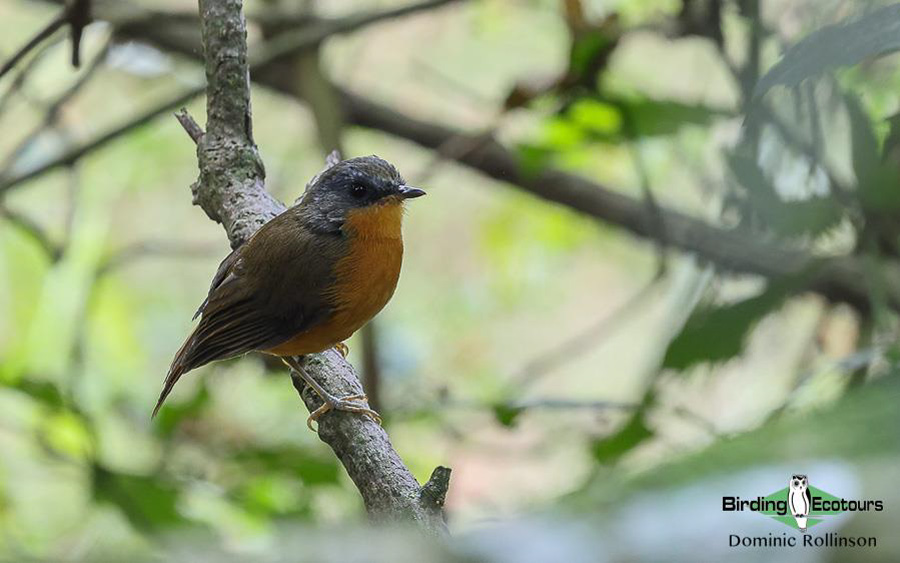
Equatorial Akalat was seen well in the Ruhija area.
To finish off the day, we headed back into the bamboo zone to see if we could find any Handsome Spurfowl, but the best we could do was to hear some rather distant birds calling from the valleys below us. We drove back along the road as it was getting dark and flushed a Montane Nightjar that was too quick for us all to get onto; however, a pair of African Wood Owls did pose nicely for us.
Day 8, 18th July 2023. Birding Ruhija and The Neck, and transfer to Buhoma
This morning, we were keen to try and track down a few missing targets and so headed back to the bamboo zone. Handsome Spurfowl was again not playing ball; however, we did find White-headed Wood Hoopoe, and finally, all got good (although brief) looks at Dusky Crimsonwing, which was one of David’s most-wanted targets. We headed back to the school track for one more go at Grauer’s Warbler, which eventually showed briefly for us (along with a couple of Blue Monkeys) before we made our way out of Ruhija towards Buhoma with some birding en route at The Neck to look forward to. As we were leaving the forests of Ruhija, we stopped to enjoy a group of handsome Guerezas (Black-and-white Colobus), which posed nicely for us.
We spent a good few hours birding at The Neck, which proved to be some of the best birding of the trip, and also enjoyed our lunch break in the relative cool of the forest. A stop at the stream failed to deliver the hoped-for Mountain Wagtail and Cassin’s Flycatcher; however, we did find Speckled Tinkerbird, Petit’s Cuckooshrike, Klaas’s Cuckoo, White-browed Crombec and White-breasted Nigrita.
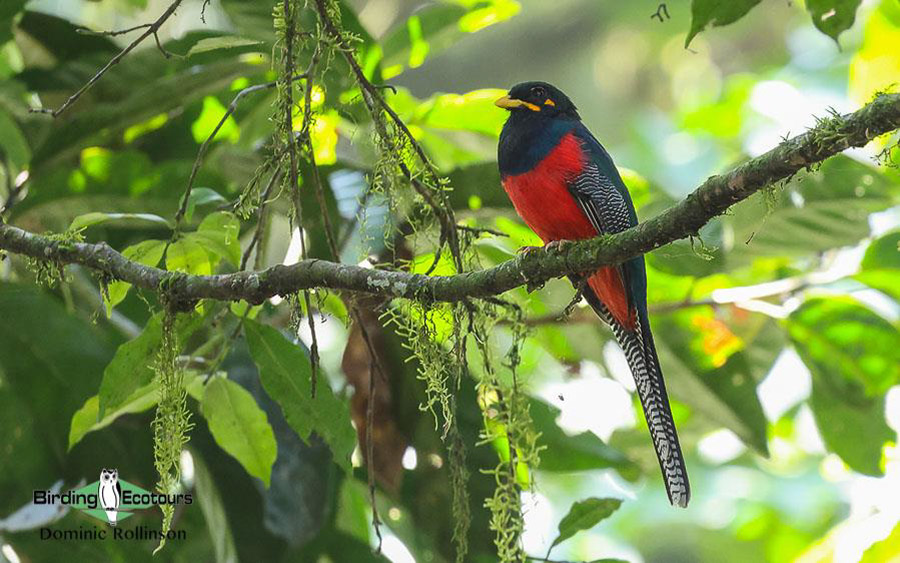
We had splendid views of Bar-tailed Trogon while birding The Neck.
A little further into the forest, we bumped into a bird party, which left us not knowing which way to look, and we soon racked up Ansorge’s, Plain, Red-tailed, Yellow-whiskered and Honeyguide Greenbuls, Banded Prinia, Bar-tailed Trogon, Yellow-spotted Barbet and Black-billed Weaver. After our lunch, the high-octane birding continued with more feeding flocks producing Blue Malkoha, Bocage’s Bushshrike, Grey-headed Sunbird, Brown-capped Weaver, Slender-billed Starling and Black-and-white Shrike-flycatcher. We waited on the edge of a small wetland and eventually had good looks at a pair of African Black Ducks, which are often seen here.
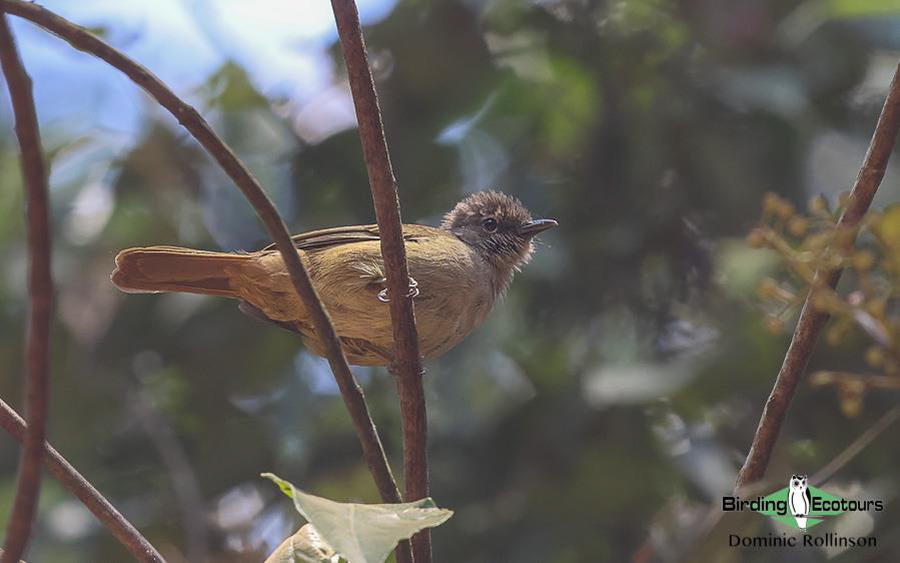
The subtly beautiful Ansorge’s Greenbul at The Neck.
We arrived in the early afternoon in Buhoma, checked into our lodging and had a short break before our late-afternoon birding session. This afternoon, we birded the entrance road to the Buhoma section of Bwindi Impenetrable Forest, which again proved productive for us. Right at the park entrance, a flowering tree was attracting lots of feeding sunbirds, including Green-headed, Green-throated, Olive-bellied, Bronzy and Northern Double-collared Sunbirds. Soon after starting our walk, we bumped into Wilcock’s Honeyguide – a tricky forest species, while a flyover Cassin’s Hawk-Eagle was another unexpected bonus. We worked our way through various feeding flocks, which contained Many-colored Bushshrike, Petit’s Cuckooshrike, Narrow-tailed Starling, Dusky-blue Flycatcher, Grey-throated Tit-Flycatcher and Little Green Sunbird, before we called it a day and enjoyed a traditional Ugandan dinner.
Day 9, 19th July 2023. Buhoma main trail birding
We had another early start this morning as we were to spend most of the day birding the Buhoma main trail, which offers superb deep-forest birding. We took lunch packs along with us and spent the morning and early afternoon birding in the forest interior, which produced a fine list of forest specials. Some of the day’s highlights included Bar-tailed Trogon, Grey-throated and Yellow-spotted Barbets, Cassin’s Honeyguide, Chestnut Wattle-eye, Pink-footed Puffback, Dusky Tit, Black-throated Apalis, Black-faced Rufous Warbler, Ansorge’s, Plain, Yellow-whiskered and Little Greenbuls, Sooty Flycatcher, Blue-throated Brown Sunbird and African Broadbill which we enjoyed watching for a while as it performed its display flight. At our turnaround, point we searched for Neumann’s Warbler, which although we heard nearby, we could not obtain any visuals of this cryptic forest skulker. During our walk, we also enjoyed several sightings of the attractive L’hoest’s Monkey, which were not at all perturbed by our presence. Before exiting the forest, we had an exciting encounter with the relatively large Yellow-backed Duiker, which walked along the path up to us before diving into the thick bush; we also saw several Black-fronted Duiker today. On our way back out through the secondary forest, we managed to find Grey-winged Robin-Chat and Elliot’s and Buff-spotted Woodpeckers, as well as White-rumped Swift and Red-rumped Swallow overhead.
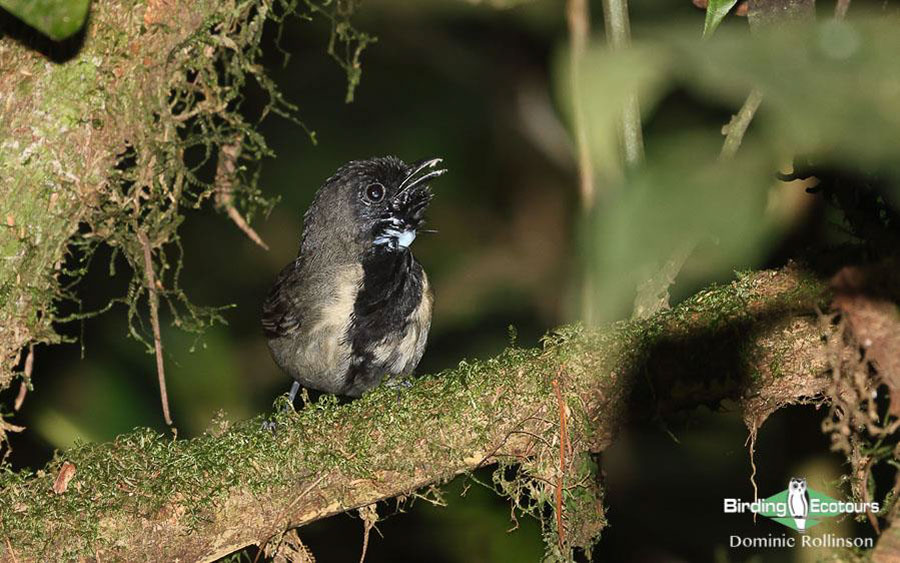
This female Black-faced Rufous Warbler showed well for us in Bwindi Impenetrable Forest.
For our afternoon birding session, we decided to take a break from forest birding and rather birded the farmlands outside of Buhoma town. Some of the afternoon’s highlights included Tambourine Dove, Ross’s Turaco, Eastern Plantain-eater, White-browed Coucal, Woolly-necked Stork, Palm-nut Vulture, White-winged Black Tit, Holub’s Golden Weaver, and two pairs of Wahlberg’s Eagles which were seen displaying to each other. This ended another fun day’s birding in the forests of Uganda.
Day 10, 20th July 2023. Gorilla trekking and late afternoon forest birding
Today was an exciting day for Barbara as she was heading out gorilla trekking for the morning. We dropped Barbara at the park headquarters, and then David, Gordon and I carried on back into the forests as we would again be birding the entrance road and the streamside track. We had many of the same species as yesterday, including Tambourine Dove, Grey-throated Barbet, Buff-spotted Woodpecker, Petit’s Cuckooshrike, Chestnut Wattle-eye, Black-and-white Shrike-flycatcher, Bocage’s Bushshrike, Green Hylia, Brown-capped Weaver and Grey-winged Robin-Chat. We had to work for our new birds but did manage to find African Goshawk, African Shrike-flycatcher, Red-tailed Bristlebill and Toro Olive Greenbul before we headed back to the park headquarters to meet up with Barbara. We were pleased to hear that Barbara had thoroughly enjoyed her time with the Eastern (Mountain) Gorillas and was lucky enough to have a small group of tourists along with her (rather than the full complement of eight), which made for a more enjoyable experience. After our busy mornings, we headed back to our lodge for a sit-down lunch and some time off in the early afternoon.
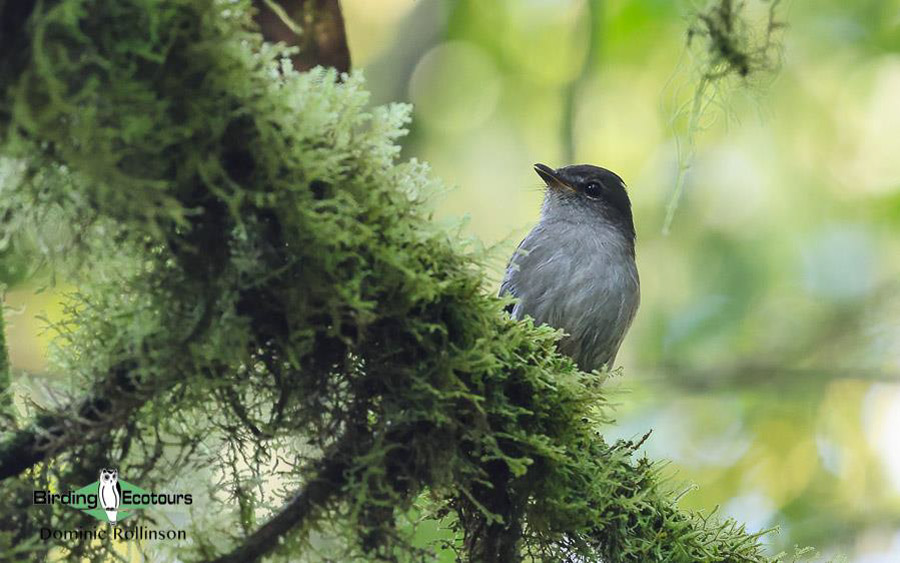
Chapin’s Flycatcher was another highlight of our time at Buhoma.
Later that afternoon we headed back out for our final session of birding the Buhoma entrance road to see if we could find some of the species that Barbara had missed in the morning while she was out gorilla trekking. The forest was very quiet this afternoon; however, we still enjoyed our walk along the edge of the stream and even managed to bump into a family group of Eastern (Mountain) Gorillas which was unexpected bonus. After a bit of work, we found a small group of Red-tailed Bristlebirds, which was a catch-up bird for Barabara. Feeling content after our time birding in Buhoma over the last couple of days, we headed back to our lodge for a good night’s sleep before an early start the next morning.
Day 11, 21st July 2023. Transfer to and birding Queen Elizabeth National Park
We had a pre-dawn breakfast before we were in our vehicle and started the transfer to Queen Elizabeth National Park. En route, we stopped near the town of Kasese, where we quickly found a Red-throated Wryneck, which posed well for us with a confiding trio of Grey Crowned Cranes feeding nearby. After refueling and drawing some cash in Kasese, we soon entered the national park and slowly started making our way northwards. Immediately, the birding picked up, and we soon saw the likes of Common Scimitarbill, Olive Bee-eater, Cardinal and Green-backed Woodpeckers, Northern Fiscal, Red-faced, Trilling and Croaking Cisticolas, Red-billed Quelea and White-winged Widowbird.
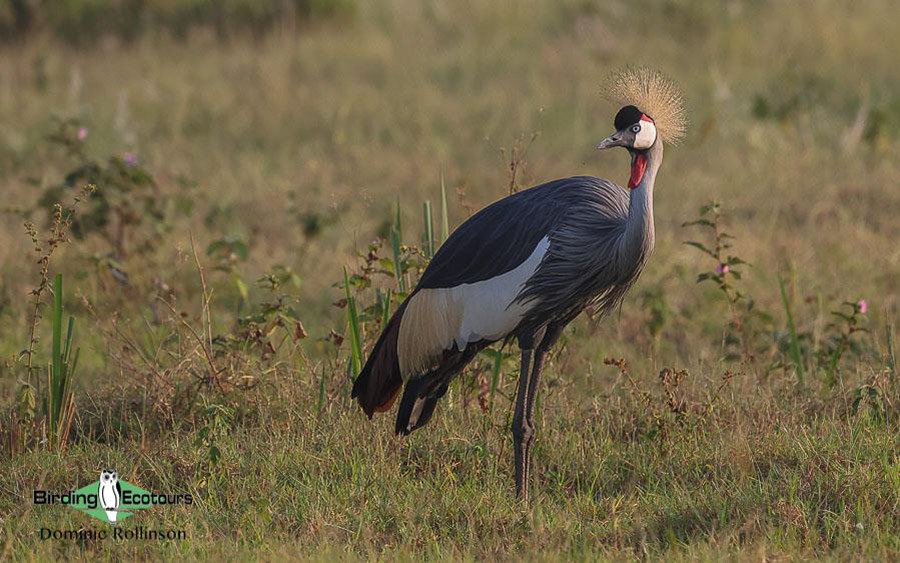
Grey Crowned Cranes were commonly encountered on this tour.
After a little while, we entered the Ishasha sector of the park; however, by this point, things had started to warm up, and the area was perhaps not quite as productive as it often can be. Despite this, we saw some good birds, including Blue-spotted Wood Dove, Marabou Stork (much to David’s delight), Hamerkop, Palm-nut, White-backed and Rüppell’s Vultures, Bateleur (which loosely means tight-rope walker in French, from its habit of tilting its wings as it flies), Brown Snake Eagle, Lesser Honeyguide, Black-headed Gonolek, Banded Martin, Flappet Lark, Quailfinch, and a pair of Verreaux’s Eagle-Owls at their day roost. We were hoping for sightings of tree-climbing Lions while in the Ishasha sector; however, we had no such luck today.
After a quick picnic lunch (while being distracted by a group of Buff-bellied Warblers), we carried on north through the park (finding a flock of Western Crested Guineafowl en route), eventually arriving at our comfortable lodge in the early afternoon. After a quick rest, we were soon out the door again and this time birded some grasslands near our lodge, where we found Moustached Grass Warbler and Marsh Tchagra but could only briefly hear Fan-tailed Grassbird, never managing to lay eyes on it.
A quick stop at the Kazinga Channel bridge eventually yielded the secretive Papyrus Gonolek (well spotted William) as well as Malachite and Pied Kingfishers, Wire-tailed Swallow and Winding Cisticola. We made a stop for nightjars on our way back which resulted in a brief view of Fiery-necked Nightjar; however, the calling Square-tailed Nightjars would not show for us.
Day 12, 22nd July 2023. Kasenyi Track birding, Kazinga Channel boat cruise and transfer to Kibale Forest
We enjoyed an early breakfast before we packed our bags and were again out early, watching the sun rise as we headed towards the Kasenyi Track. We would be birding this famed track for the morning before heading out on our lunchtime Kazinga Channel boat cruise. After sorting out the entrance fees, we were soon on our way along the track, which proved very birdy and added many new birds to our already impressive bird list. Some of the highlights of the morning included Red-necked Spurfowl (many), Mourning Collared Dove, African Crake, Senegal Lapwing, Common Buttonquail, Dwarf Bittern, Bateleur, Yellow-billed Kite, Green Wood Hoopoe, Grey Kestrel, White-tailed, Flappet and Red-capped Larks, Stout Cisticola, Yellow-billed Oxpeckers (feeding on the large herds of African Buffalo in the area), Quailfinch and Plain-backed Pipit. The area is well-known for its large numbers of game, and today, we managed to find a male Lion, a single Leopard resting in a tree, impressive herds of African Buffalo as well as Common Warthog, Kob and Waterbuck. We enjoyed the views out over Lake Bunyampaka (a crater lake), where we scoped small numbers of Lesser Flamingo, Black-winged Stilt, Spur-winged Lapwing, Common Greenshank and Kittlitz’s Plover.
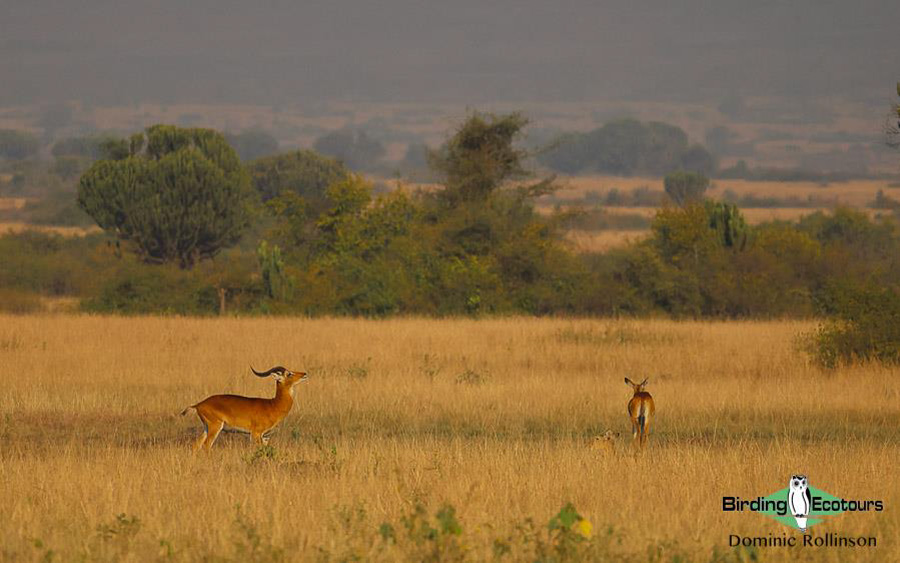
Kob are abundant in many f Uganda’s national parks.
It was then time to make our way west, enjoying a quick lunch before heading out for our much-anticipated boat cruise of the Kazinga Channel. This cruise is always a very enjoyable one, with large numbers of both birds and animals on display. Today was no different as we watched large numbers of African Elephants coming down to drink, as well as small numbers of Forest Hogs sheltering in the shade. The impressive numbers of Hippopotamuses kept us entertained as they lounged around with a few good-sized Nile Crocodiles seen basking on the exposed banks. Unfortunately, the water levels were too high for African Skimmers, which we had hoped to see, and there were none of these charismatic birds around.
Despite the lack of skimmers, the birding overall was excellent, and by working through the more familiar species we were able to pick out Knob-billed Duck, Water Thick-knee, African Jacana, Common Sandpiper, Grey-headed Gull, Yellow-billed Stork, White-breasted Cormorant, Great White and Pink-backed Pelicans, Goliath and Squacco Herons, Pied Kingfisher (in the highest concentrations I have ever seen), Red-throated Bee-eater and many other widespread species.
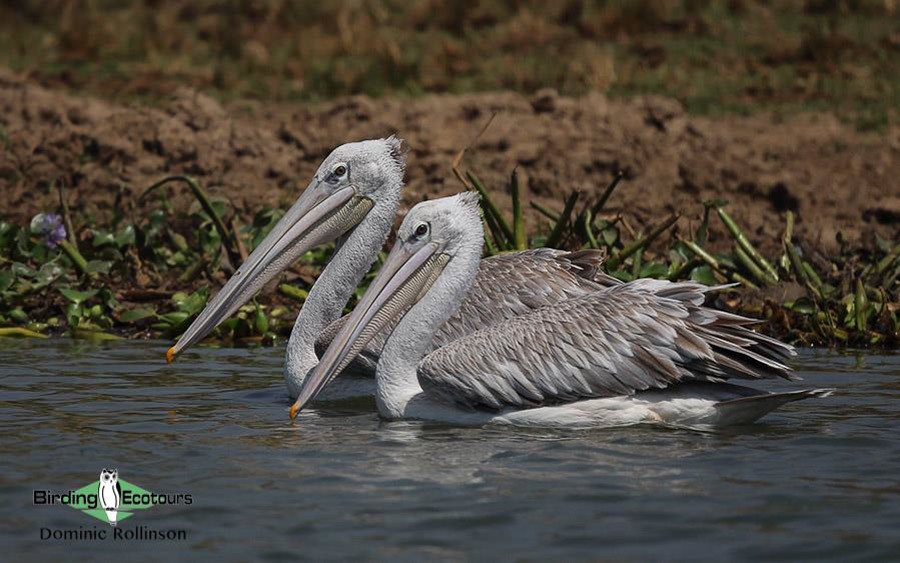
Pink-backed Pelicans on the Kazinga Channel.
After a relaxing and highly enjoyable cruise, we made the journey north to Kibale Forest, where we would be based for the next two nights. A quick stop as we drove through the forest added Sabine’s Spinetail and Purple-headed Starling before we arrived at our lodge as the sun was setting.
Day 13, 23rd July 2023. Kibale Forest birding
Today was another highly anticipated day of birding as we made our way into Kibale Forest pre-dawn to look for the most-wanted Green-breasted Pitta. The pittas had proven tricky this season, with a few previous birding tours having missed them. I had chatted to William about the pittas, and he had said from the start that he would make sure we saw them, and he stayed true to his word, as we had mind-blowing views for around 15 minutes watching a bird displaying, doing its little jump and wing drumming. It was a magical experience, and we were all very relieved to have seen this attractive and elusive species. While out looking for the pittas, we also found Brown Illadopsis, Yellow-throated Tinkerbird and heard many Western Orioles, although we could not lay eyes on them yet.
After our successful morning out, we birded the forest edge, which proved equally productive as we soon found Jameson’s Wattle-eye, Lowland Masked and Grey Apalises, Blue Malkoha, Western Nicator (which William somehow spotted sat on its nest!), African Shrike-flycatcher (catchup bird for Barbara), Plain Greenbul and Purple-banded Sunbird.
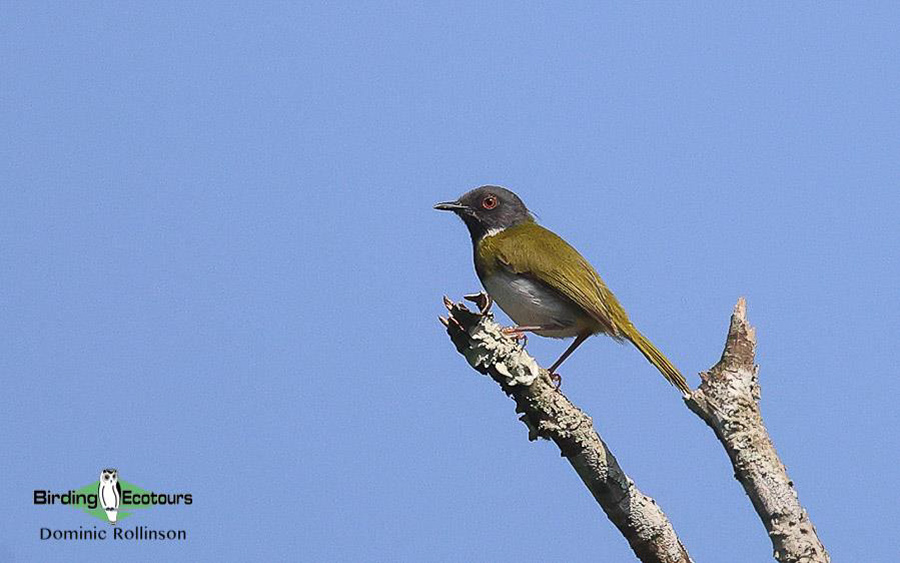
Lowland Masked Apalis was particularly confiding on the edge of Kibale Forest.
We then headed back to our lodge for a sit-down lunch and some time off in the early afternoon. Feeling refreshed, we headed out again for our afternoon’s birding around Bigodi Swamp. The birding was a little on the slow side; however, we did add some new birds in the form of White-spotted Flufftail (great looks as an individual walked across the path), Ayres’s Hawk-Eagle, Shining-blue Kingfisher (unfortunately missed by David and Barbara), Purple-headed Starling and a few flyover flocks of Magpie Mannikins.
Day 14, 24th July 2023. Kibale Forest birding and transfer to Masindi
Today we had the long transfer to Masindi ahead of us, but before that, we wanted to get in some last birding around Kibale Forest and the surrounds. After breakfast, we birded the area close to Bigodi Swamp, which was very productive, and we managed to find our primary target, Speckle-breasted Woodpecker. Other good birds seen included Brown-throated Wattle-eye, Black-and-white Shrike-flycatcher, African Blue Flycatcher, Copper Sunbird, Baglafecht Weaver and several showy Great Blue Turacos.
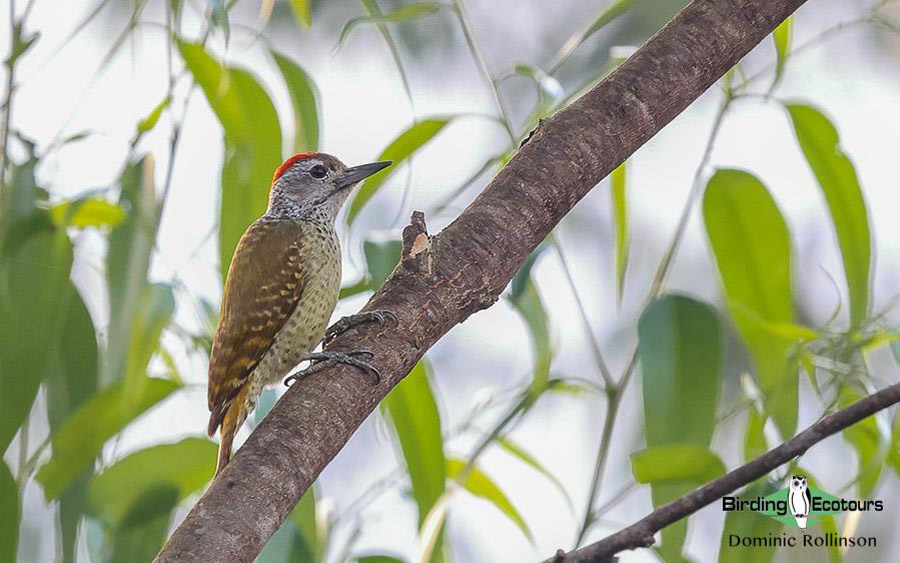
Speckle-breasted Woodpecker showed wonderfully well near Kibale Forest.
We then spent some time birding in Kibale Forest to try to find a few missing targets. A stop at the stream produced the hoped-for Cassin’s Flycatcher which we had missed previously, with other previously encountered species including African Shrike-flycatcher, African Green Pigeon, Black-billed Turaco, Sabine’s Spinetail, Grey-throated and Hairy-breasted Barbets, Yellow-throated Tinkerbird, Cassin’s Honeybird, Chestnut Wattle-eye, Dusky Tit, Purple-banded Sunbird and Grey-headed Nigrita. New trip birds included the likes of Afep Pigeon, Dusky Long-tailed Cuckoo (finally seen, after having heard it for the last few days), European Honey Buzzard, Red-capped Robin-Chat (brief glimpses as it flew across the road) and the aptly named Superb Sunbird. We were also lucky to be able to watch a group of Chimpanzees as they fed high up in a fruiting fig tree – it’s always a pleasure to watch these fascinating apes in the wild. Kibale Forest is well-known for its diversity of primates. While birding in the forest and general area over the last couple of days, we also noted Grey-cheeked Mangabey, Olive Baboon, Red-tailed Monkey and Ashy Red Colobus (which is the favored prey of Chimpanzees, due to their slow-moving nature).
After exiting Kibale Forest, the remainder of the day was mostly a travel day as we continued our way north to the town of Masindi. We made a stop for Red-headed Bluebill and another stop for Grey-headed Oliveback; however, both stops proved unsuccessful. After a long day on the road, we arrived in the late afternoon and enjoyed our dinner before heading to bed.
Day 15, 25th July 2023. Budongo Forest birding and transfer to Murchison Falls
We had a long day’s birding ahead of us today, with lots to fit in, so we decided on another pre-dawn breakfast before making our way out of Masindi, heading towards Budongo Forest. Before we made it into the forest, we had several birds to target in the farmlands on the outskirts of the forest. Our first stop was for White-winged Swamp Warbler, which did not take long to finally get visuals of, after having heard it many times previously. A few farmland stops proved very birdy, and it did not take long before we had accumulated an impressive list, including Senegal Coucal, Red-necked Falcon (well spotted David, this turned out to be our only sighting of the trip!), Marsh Tchagra, Moustached Grass Warbler, Short-winged Cisticola, Brown-backed Scrub Robin, Compact Weaver, Yellow-mantled and Red-collared Widowbirds, Black Bishop, Fawn-breasted and Orange-breasted Waxbills and African Firefinch. I had brief views of a small group of Brown Babblers, but unfortunately, nobody else got onto these birds.
We then moved around the corner to try for Grey-headed Oliveback with a pair of these attractive finches showing wonderfully well for a prolonged period. At the same time, we also had a pair of Brown Twinspots, which also showed well. In this area we further saw Red-headed Lovebird, Meyer’s Parrot, Grey-backed Fiscal, Snowy-crowned Robin-Chat, Compact Weaver and had a displaying African Goshawk overhead.
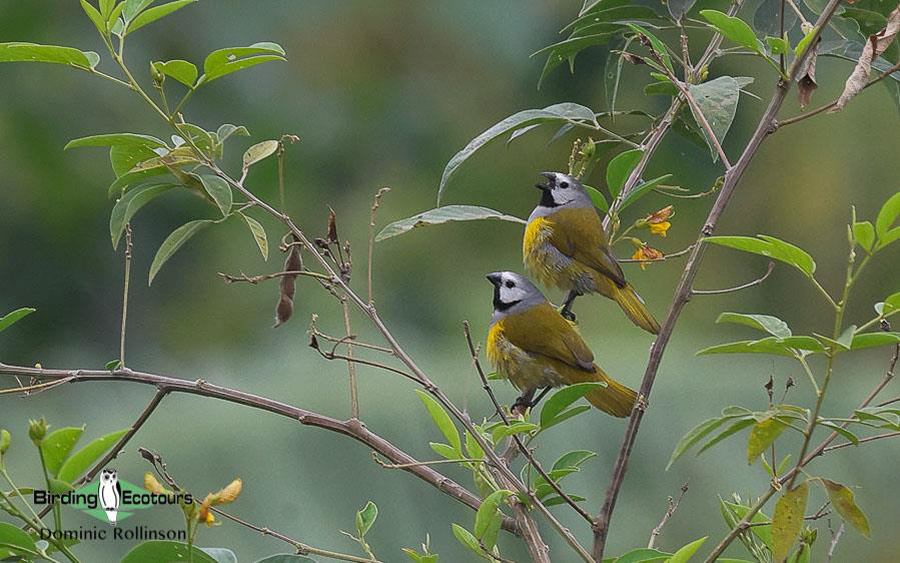
We could not have asked for better views of this pair of Grey-headed Olivebacks near to Budongo Forest.
Around mid-morning, we finally made it into Budongo Forest itself and proceeded to bird the famed Royal Mile which as always, was full of birds. Birding along the Royal Mile can be difficult at times, with flocks feeding high up in the canopy, often meaning a scope is needed to get views of many of the canopy dwellers. Our first feeding flock contained Little Grey Greenbul, Grey Longbill, Ashy Flycatcher, Little Green Sunbird, Green Crombec and Green Hylia. Nearby, we had superb views of a pair of Yellow-crested Woodpeckers. We then moved deeper into the forest and soon found a feeding party of birds high up in the canopy, which had us craning our necks upwards and managed to pick out Chestnut-capped Flycatcher and Spotted Greenbul, with glimpses of Rufous-crowned Eremomela and Ituri Batis (unfortunately Barbara and David missed these two). We had a fun time with kingfishers as we all managed good looks at African Pygmy and African Dwarf Kingfishers, with Chocolate-backed Kingfishers eventually showing very well for us. The calling Blue-breasted Kingfishers, however, would not show themselves, for now.
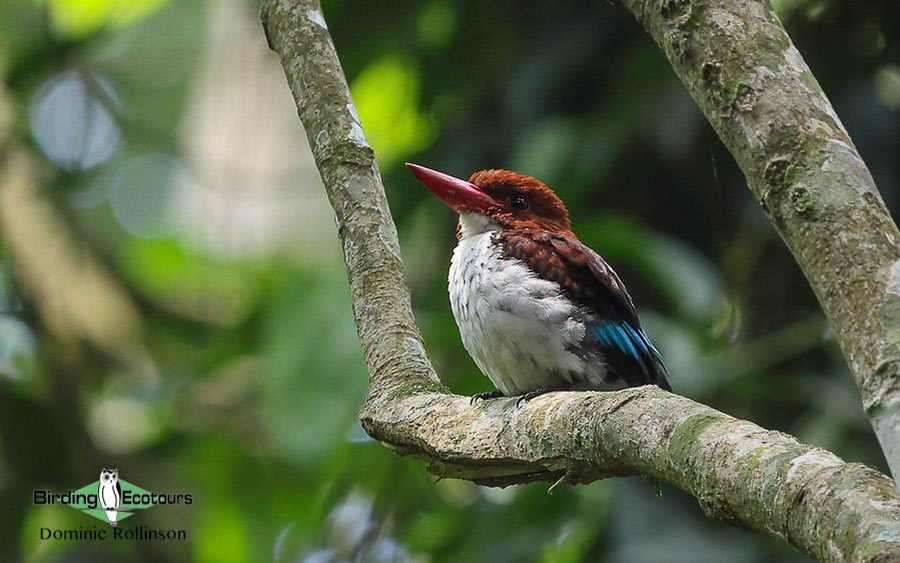
Chocolate-backed Kingfisher was one of the many kingfishers we saw along the Royal Mile.
After our picnic lunch, we continued to bird the forest and managed to find good birds in the form of White-thighed Hornbill, African Emerald Cuckoo (female), Western Oriole, Red-bellied Paradise Flycatcher, Fraser’s Rufous Thrush, Fraser’s Forest Flycatcher and Red-headed Malimbe. Unfortunately, we could not find the calling Uganda Woodland Warbler, which too was calling high up in the forest canopy.
After a few good hours of lowland forest birding, we decided it was time to hit the road and make our way towards Murchison Falls National Park. We wanted to take our time getting to Murchison Falls, as there was some fine birding to be had en route. We stopped off at the Butiaba Escarpment, where a drastic change in habitat (here dry woodlands) meant the new birds came rolling in thick and fast. Some of the exciting birds found here included Bateleur, African Hawk-Eagle, Swallow-tailed Bee-eater, Black-billed Barbet, Northern Crombec, Foxy Cisticola, Lesser Blue-eared Starling, Western Violet-backed and Beautiful Sunbirds, Vitelline Masked Weaver, Red-headed Quelea, Black-rumped Waxbill and Green-winged Pytilia. We moved further round the corner, where we had lovely views of Cinnamon-breasted Bunting, with the great birding continuing as we worked through the large flocks of seedeaters, picking out Cut-throat Finch and Village Indigobird. We then tried our best not to spot any exciting birds and drove the last hour or two to Murchison Falls, with William and I spotting a brief flyover Bruce’s Green Pigeon as we entered the park.
Day 16, 26th July 2023. Birding Murchison Falls National Park
We had the exciting prospect of the full day in Murchison Falls National Park today and so after an early breakfast, we crossed the bridge over the Nile River and enjoyed the day of birding and animal viewing. Woodland birding produced sightings of Black-billed Wood Dove, Jacobin Cuckoo, Grey-headed Kingfisher, Northern Carmine Bee-eater, Yellow-fronted Tinkerbird, Western Black-headed Batis, White-shouldered Black Tit, Black-crowned and Brown-crowned Tchagras, Rattling Cisticola, Silverbird, Spotted Palm Thrush, Chestnut-crowned and White-browed Sparrow-Weavers, Speckle-fronted Weaver, Shelley’s Sparrow, Black-bellied Firefinch and many others. The open grasslands had good numbers of Northern Red and Black-winged Bishops, Flappet Lark, Banded Martin, Black-headed Lapwing and a group of massive Abyssinian Ground Hornbills. Overhead, there were several raptors using the thermals, including Lappet-faced, White-backed and Rüppell’s Vultures, Bateleur and Martial and Wahlberg’s Eagles with Western Banded Snake Eagle and Dark Chanting Goshawk seen perched in tall trees. While out birding in the plains and savannas of Murchison, we noted good numbers of game, including Oribi, Waterbuck, Kob, Hartebeest and masses of African Buffalo.
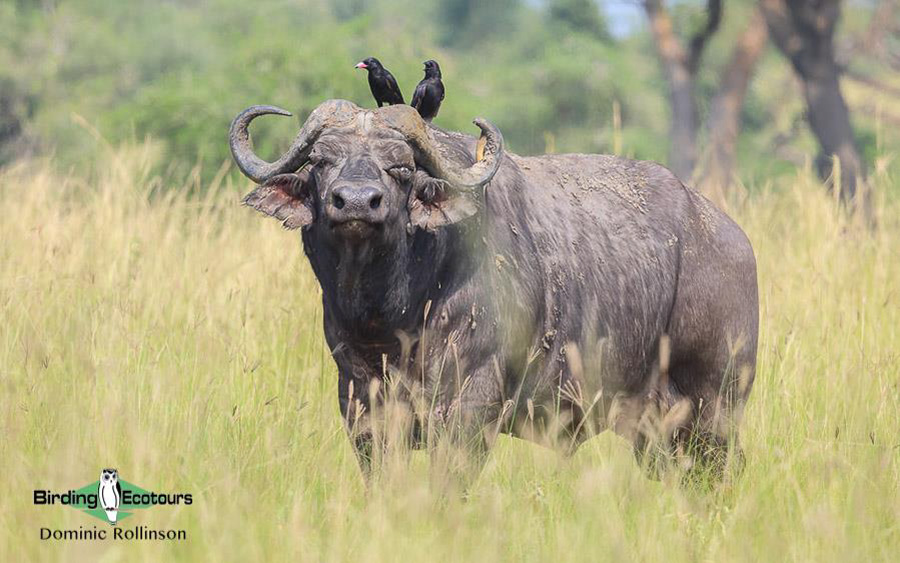
Piapiacs adorned the many African Buffalo in Murchison Falls National Park.
We enjoyed our lunch along the edge of Lake Albert, where we scoped Spur-winged and Long-toed Lapwings, Common Greenshank, African Openbill, Saddle-billed and Yellow-billed Storks, Intermediate Egret and Pink-backed Pelican before we started to slowly make our way back towards our lodge. We eventually made it back to our lodge in the late afternoon and decided to take the rest of the afternoon off and enjoy the beautiful lodge grounds and a quiet beer.
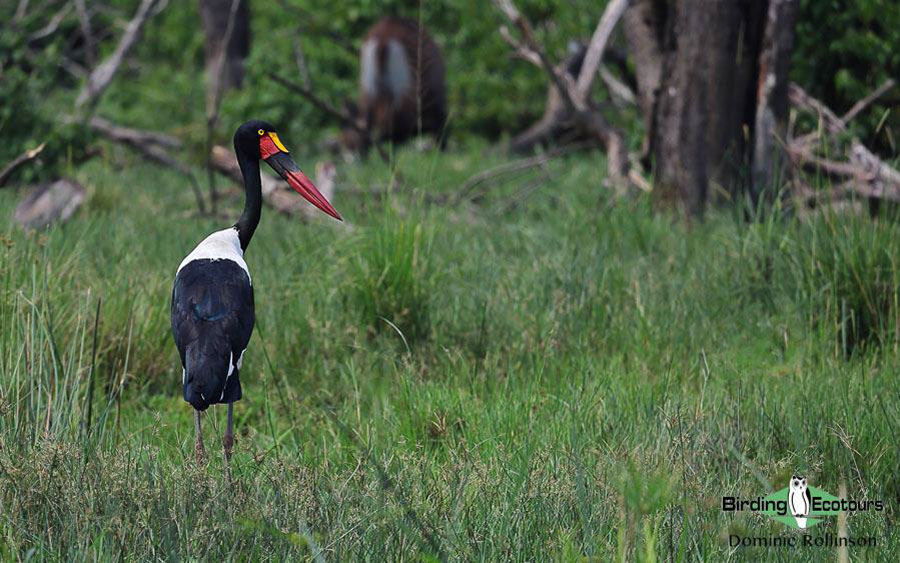
Saddle-billed Storks are often seen well in Murchison Falls National Park.
Day 17, 27th July 2023. Nile River boat cruise and birding Murchison Falls
This morning, we slowly birded the road between our lodge and Paraa, which again proved very productive with lots of new birds. We found a few bird parties, which contained the likes of Nubian Woodpecker, Western Black-headed Batis, White-crested Helmetshrike, White-shouldered Black Tit, Green-backed Eremomela, Red-winged Grey Warbler, Singing and Short-winged Cisticolas and Northern Yellow White-eye. We had to work for Grey-headed Bushshrike, but eventually, William spotted a bird calling from a distant tree, which we could all enjoy. William and I had a brief view of a male Red-shouldered Cuckooshrike as it flew across the road that was unfortunately missed by David and Barbara.
We then birded the northern side of the Nile River, which got us our two main targets for the day; White-crested Turaco and a small group of Dusky Babblers, with Pale Flycatcher and Bar-breasted Firefinch seen in the area too.
We had our picnic lunch on the edge of the Nile River while sat on a wobbly bench, which almost sent David and Barbara flying, but thankfully, all ended well, and we could laugh about it. It was then time for our Nile River boat cruise, which as always, proved to be very relaxing as we headed out to see Murchison Falls itself which is always impressive to see and hear. The birding was productive along the cruise, and we added Senegal Thick-knee, Rock Pratincole, Osprey, Giant Kingfisher and Common Swift to our trip list. Other nice birds to be seen included Red-throated Bee-eater, Goliath Heron, Grey Kestrel and Saddle-billed Stork. We also enjoyed some close-up sightings of African Buffalo, African Elephant, Hippopotamus and Nile Crocodile.
After our boat cruise, we birded the main road near our lodge in the hopes of finding Blue-breasted Kingfisher, which played hide-and-seek for a while before we eventually managed brief views of this attractive kingfisher. As the sun was setting, we drove a track where we managed a few brief flyover views of impressive male Pennant-winged Nightjars and had brief looks at Blue-throated Roller as it hawked insects in amongst the many Broad-billed Rollers.
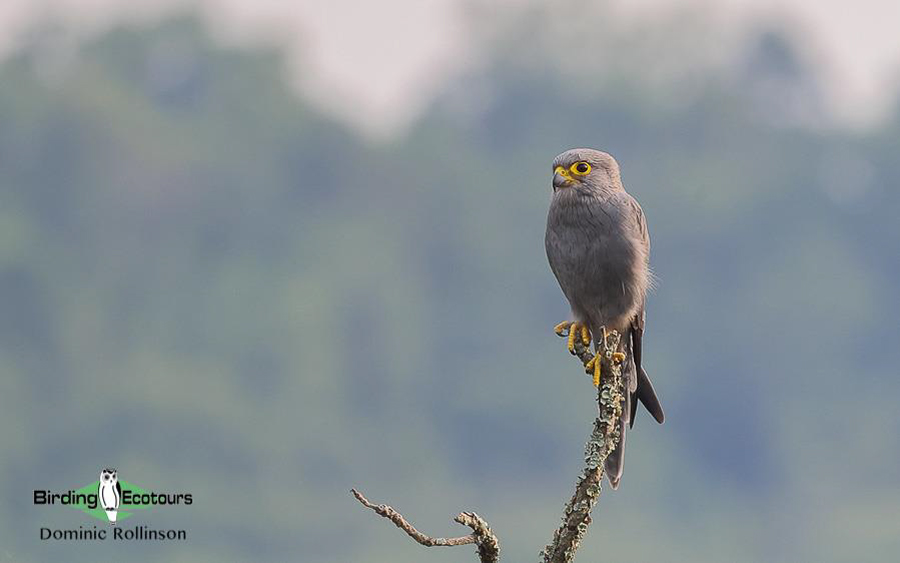
Grey Kestrel is common in savanna habitat across Uganda.
Day 18, 28th July 2023. Murchison Falls to Entebbe, with Ziwa Rhino Sanctuary en route
Today was our final full day of the tour, and we would be slowly making our way back to Entebbe, with several birding and wildlife stops to be enjoyed en route. After our sit-down breakfast we stopped at Kaniyo Pabidi Forest where we enjoyed some more lowland forest birding with highlights including Western Crested Guineafowl, Narina Trogon (calling only), African Dwarf Kingfisher, Blue-breasted Kingfisher (flying overhead), Western Oriole (seen well at last), Spotted Greenbul (seen much better this time), Fraser’s Rufous Thrush, Blue-throated Brown Sunbird, Red-headed Malimbe and Yellow-mantled Weaver. We tried again for Forest Robin, which was calling close to the road; however, this bird continued to elude us.
We then continued south and stopped at Ziwa Rhino Sanctuary, where we were shown some of the White Rhinoceroses which are protected in this sanctuary. We enjoyed watching a mother with her young calf as they quietly grazed and were told of the plight of this species in the country, but we were happy to hear how conservation efforts plan to return this iconic species to the plains of Uganda. Other species seen around Ziwa included Grey Crowned Crane, Nubian Woodpecker, Yellow-fronted Tinkerbird, Double-toothed Barbet, African Golden Oriole, Whistling Cisticola and Grey Tit-Flycatcher.
Our final birding stop was at a roadside marsh where we found our target Marsh Widowbird as well as several Fan-tailed Widowbirds, before making our way through the chaos of Kampala and into Entebbe, where we would spend our final night on tour.
Day 19, 29th July 2023. Departure from Entebbe
After a busy 18 days around Uganda, we decided to take it easy for the morning, and after a final lunch, David and Barbara caught their afternoon flights out of the Pearl of Africa. Thanks to William, our trusty driver and eagle-eyed local guide, for helping make this trip the success it was. I look forward to visiting again soon!
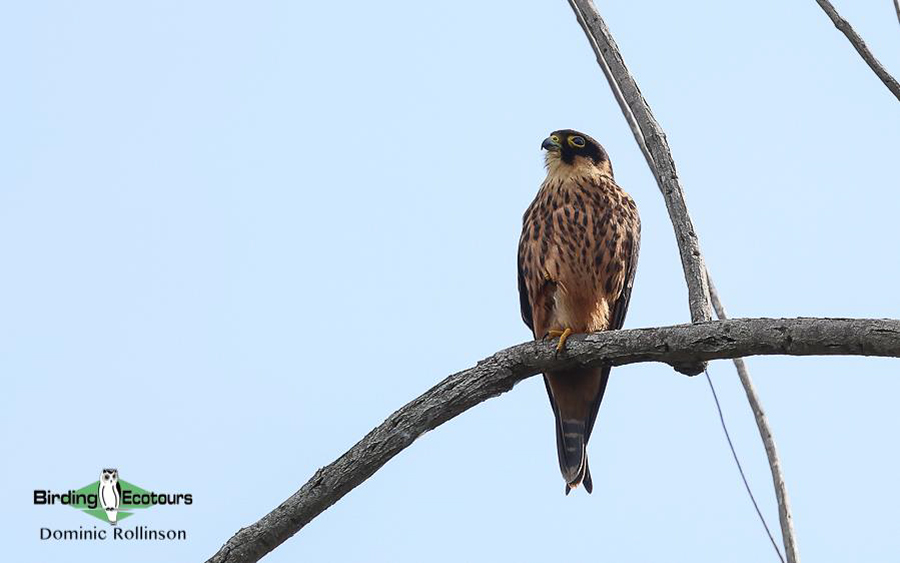
Entebbe must be one of the best places to find African Hobby.
Bird List – Following IOC (12.1)
Birds ‘heard only’ are marked with (H) after the common name, birds seen by the guide only are marked with a (G) after the common name, all other species were seen both by clients and guide.
The following notation after species names is used to show conservation status following BirdLife International. CR = Critically Endangered, EN = Endangered, VU = Vulnerable.
Albertine Rift endemics are bolded.
| Common Name | Scientific Name |
| Ducks, Geese, Swans (Anatidae) | |
| White-faced Whistling Duck | Dendrocygna viduata |
| White-backed Duck | Thalassornis leuconotus |
| Knob-billed Duck | Sarkidiornis melanotos |
| Egyptian Goose | Alopochen aegyptiaca |
| African Black Duck | Anas sparsa |
| Yellow-billed Duck | Anas undulata |
| Guineafowl (Numididae) | |
| Helmeted Guineafowl | Numida meleagris |
| Crested Guineafowl | Guttera pucherani |
| Pheasants & Allies (Phasianidae) | |
| Crested Francolin | Ortygornis sephaena |
| Coqui Francolin (H) | Campocolinus coqui |
| Handsome Spurfowl (H) | Pternistis nobilis |
| Heuglin’s Spurfowl (H) | Pternistis icterorhynchus |
| Red-necked Spurfowl | Pternistis afer |
| Nightjars (Caprimulgidae) | |
| Black-shouldered Nightjar | Caprimulgus nigriscapularis |
| Montane Nightjar (G) | Caprimulgus poliocephalus |
| Swamp Nightjar | Caprimulgus natalensis |
| Freckled Nightjar (H) | Caprimulgus tristigma |
| Square-tailed Nightjar (H) | Caprimulgus fossii |
| Pennant-winged Nightjar | Caprimulgus vexillarius |
| Swifts (Apodidae) | |
| Scarce Swift | Schoutedenapus myoptilus |
| Sabine’s Spinetail | Rhaphidura sabini |
| African Palm Swift | Cypsiurus parvus |
| Common Swift | Apus apus |
| Little Swift | Apus affinis |
| White-rumped Swift | Apus caffer |
| Turacos (Musophagidae) | |
| Great Blue Turaco | Corythaeola cristata |
| Bare-faced Go-away-bird | Crinifer personatus |
| Eastern Plantain-eater | Crinifer zonurus |
| Rwenzori Turaco | Gallirex johnstoni |
| Ross’s Turaco | Tauraco rossae |
| White-crested Turaco | Tauraco leucolophus |
| Black-billed Turaco | Tauraco schuettii |
| Cuckoos (Cuculidae) | |
| Senegal Coucal | Centropus senegalensis |
| Blue-headed Coucal | Centropus monachus |
| White-browed Coucal | Centropus superciliosus |
| Blue Malkoha | Ceuthmochares aereus |
| Levaillant’s Cuckoo | Clamator levaillantii |
| Jacobin Cuckoo | Clamator jacobinus |
| Diederik Cuckoo | Chrysococcyx caprius |
| Klaas’s Cuckoo | Chrysococcyx klaas |
| African Emerald Cuckoo | Chrysococcyx cupreus |
| Dusky Long-tailed Cuckoo | Cercococcyx mechowi |
| Barred Long-tailed Cuckoo | Cercococcyx montanus |
| Red-chested Cuckoo | Cuculus solitarius |
| Pigeons, Doves (Columbidae) | |
| Rock Dove | Columba livia |
| Speckled Pigeon | Columba guinea |
| Afep Pigeon | Columba unicincta |
| African Olive Pigeon | Columba arquatrix |
| Dusky Turtle Dove | Streptopelia lugens |
| Mourning Collared Dove | Streptopelia decipiens |
| Red-eyed Dove | Streptopelia semitorquata |
| Ring-necked Dove | Streptopelia capicola |
| Vinaceous Dove | Streptopelia vinacea |
| Laughing Dove | Spilopelia senegalensis |
| Emerald-spotted Wood Dove | Turtur chalcospilos |
| Black-billed Wood Dove | Turtur abyssinicus |
| Blue-spotted Wood Dove | Turtur afer |
| Tambourine Dove | Turtur tympanistria |
| Bruce’s Green Pigeon (G) | Treron waalia |
| African Green Pigeon | Treron calvus |
| Finfoots (Heliornithidae) | |
| African Finfoot | Podica senegalensis |
| Flufftails (Sarothruridae) | |
| White-spotted Flufftail | Sarothrura pulchra |
| Red-chested Flufftail (H) | Sarothrura rufa |
| Rails, Crakes & Coots (Rallidae) | |
| African Rail | Rallus caerulescens |
| African Crake | Crecopsis egregia |
| Common Moorhen | Gallinula chloropus |
| Red-knobbed Coot | Fulica cristata |
| African Swamphen | Porphyrio madagascariensis |
| Black Crake | Zapornia flavirostra |
| Cranes (Gruidae) | |
| Grey Crowned Crane – EN | Balearica regulorum |
| Grebes (Podicipedidae) | |
| Little Grebe | Tachybaptus ruficollis |
| Flamingos (Phoenicopteridae) | |
| Lesser Flamingo | Phoeniconaias minor |
| Buttonquail (Turnicidae) | |
| Common Buttonquail | Turnix sylvaticus |
| Stone-curlews, Thick-knees (Burhinidae) | |
| Senegal Thick-knee | Burhinus senegalensis |
| Water Thick-knee | Burhinus vermiculatus |
| Stilts, Avocets (Recurvirostridae) | |
| Black-winged Stilt | Himantopus himantopus |
| Plovers (Charadriidae) | |
| Long-toed Lapwing | Vanellus crassirostris |
| Spur-winged Lapwing | Vanellus spinosus |
| Black-headed Lapwing | Vanellus tectus |
| Senegal Lapwing | Vanellus lugubris |
| Crowned Lapwing | Vanellus coronatus |
| African Wattled Lapwing | Vanellus senegallus |
| Brown-chested Lapwing | Vanellus superciliosus |
| Kittlitz’s Plover | Charadrius pecuarius |
| Jacanas (Jacanidae) | |
| African Jacana | Actophilornis africanus |
| Sandpipers, Snipes (Scolopacidae) | |
| Common Sandpiper | Actitis hypoleucos |
| Wood Sandpiper | Tringa glareola |
| Common Greenshank | Tringa nebularia |
| Coursers, Pratincoles (Glareolidae) | |
| Rock Pratincole | Glareola nuchalis |
| Gulls, Terns, Skimmers (Laridae) | |
| Grey-headed Gull | Chroicocephalus cirrocephalus |
| White-winged Tern | Chlidonias leucopterus |
| Storks (Ciconiidae) | |
| Yellow-billed Stork | Mycteria ibis |
| African Openbill | Anastomus lamelligerus |
| Woolly-necked Stork | Ciconia episcopus |
| Saddle-billed Stork | Ephippiorhynchus senegalensis |
| Marabou Stork | Leptoptilos crumenifer |
| Anhingas, Darters (Anhingidae) | |
| African Darter | Anhinga rufa |
| Cormorants, Shags (Phalacrocoracidae) | |
| Reed Cormorant | Microcarbo africanus |
| White-breasted Cormorant | Phalacrocorax lucidus |
| Ibises, Spoonbills (Threskiornithidae) | |
| African Sacred Ibis | Threskiornis aethiopicus |
| Hadada Ibis | Bostrychia hagedash |
| Glossy Ibis | Plegadis falcinellus |
| African Spoonbill | Platalea alba |
| Herons, Bitterns (Ardeidae) | |
| Little Bittern | Ixobrychus minutus |
| Dwarf Bittern | Ixobrychus sturmii |
| White-backed Night Heron | Gorsachius leuconotus |
| Striated Heron | Butorides striata |
| Squacco Heron | Ardeola ralloides |
| Rufous-bellied Heron | Ardeola rufiventris |
| Western Cattle Egret | Bubulcus ibis |
| Grey Heron | Ardea cinerea |
| Black-headed Heron | Ardea melanocephala |
| Goliath Heron | Ardea goliath |
| Purple Heron | Ardea purpurea |
| Great Egret | Ardea alba |
| Intermediate Egret | Ardea intermedia |
| Little Egret | Egretta garzetta |
| Hamerkop (Scopidae) | |
| Hamerkop | Scopus umbretta |
| Shoebill (Balaenicipitidae) | |
| Shoebill – VU | Balaeniceps rex |
| Pelicans (Pelecanidae) | |
| Great White Pelican | Pelecanus onocrotalus |
| Pink-backed Pelican | Pelecanus rufescens |
| Ospreys (Pandionidae) | |
| Western Osprey | Pandion haliaetus |
| Kites, Hawks, Eagles (Accipitridae) | |
| Black-winged Kite | Elanus caeruleus |
| African Harrier-Hawk | Polyboroides typus |
| Palm-nut Vulture | Gypohierax angolensis |
| European Honey Buzzard | Pernis apivorus |
| African Cuckoo-Hawk | Aviceda cuculoides |
| Hooded Vulture – CR | Necrosyrtes monachus |
| White-backed Vulture – CR | Gyps africanus |
| Rüppell’s Vulture – CR | Gyps rueppelli |
| Lappet-faced Vulture – EN | Torgos tracheliotos |
| Black-chested Snake Eagle | Circaetus pectoralis |
| Brown Snake Eagle | Circaetus cinereus |
| Western Banded Snake Eagle | Circaetus cinerascens |
| Bateleur – EN | Terathopius ecaudatus |
| Bat Hawk | Macheiramphus alcinus |
| Crowned Eagle (H) | Stephanoaetus coronatus |
| Martial Eagle – EN | Polemaetus bellicosus |
| Long-crested Eagle | Lophaetus occipitalis |
| Wahlberg’s Eagle | Hieraaetus wahlbergi |
| Ayres’s Hawk-Eagle | Hieraaetus ayresii |
| Cassin’s Hawk-Eagle | Aquila africana |
| African Hawk-Eagle | Aquila spilogaster |
| Lizard Buzzard | Kaupifalco monogrammicus |
| Dark Chanting Goshawk | Melierax metabates |
| African Goshawk | Accipiter tachiro |
| Shikra | Accipiter badius |
| Rufous-breasted Sparrowhawk | Accipiter rufiventris |
| Black Sparrowhawk | Accipiter melanoleucus |
| African Marsh Harrier | Circus ranivorus |
| Yellow-billed Kite | Milvus aegyptius |
| African Fish Eagle | Haliaeetus vocifer |
| Augur Buzzard | Buteo augur |
| Barn Owls (Tytonidae) | |
| Western Barn Owl | Tyto alba |
| Owls (Strigidae) | |
| Pearl-spotted Owlet | Glaucidium perlatum |
| African Scops Owl (H) | Otus senegalensis |
| Southern White-faced Owl | Ptilopsis granti |
| Verreaux’s Eagle-Owl | Bubo lacteus |
| African Wood Owl | Strix woodfordii |
| Mousebirds (Coliidae) | |
| Speckled Mousebird | Colius striatus |
| Blue-naped Mousebird | Urocolius macrourus |
| Trogons (Trogonidae) | |
| Narina Trogon (H) | Apaloderma narina |
| Bar-tailed Trogon | Apaloderma vittatum |
| Hoopoes (Upupidae) | |
| African Hoopoe | Upupa africana |
| Wood Hoopoes (Phoeniculidae) | |
| White-headed Wood Hoopoe | Phoeniculus bollei |
| Green Wood Hoopoe | Phoeniculus purpureus |
| Common Scimitarbill | Rhinopomastus cyanomelas |
| Ground Hornbills (Bucorvidae) | |
| Abyssinian Ground Hornbill – VU | Bucorvus abyssinicus |
| Hornbills (Bucerotidae) | |
| Crowned Hornbill | Lophoceros alboterminatus |
| African Pied Hornbill | Lophoceros fasciatus |
| African Grey Hornbill | Lophoceros nasutus |
| White-thighed Hornbill | Bycanistes albotibialis |
| Black-and-white-casqued Hornbill | Bycanistes subcylindricus |
| Rollers (Coraciidae) | |
| Lilac-breasted Roller | Coracias caudatus |
| Blue-throated Roller (G) | Eurystomus gularis |
| Broad-billed Roller | Eurystomus glaucurus |
| Kingfishers (Alcedinidae) | |
| Chocolate-backed Kingfisher | Halcyon badia |
| Grey-headed Kingfisher | Halcyon leucocephala |
| Striped Kingfisher | Halcyon chelicuti |
| Blue-breasted Kingfisher | Halcyon malimbica |
| Woodland Kingfisher | Halcyon senegalensis |
| African Dwarf Kingfisher | Ispidina lecontei |
| African Pygmy Kingfisher | Ispidina picta |
| Malachite Kingfisher | Corythornis cristatus |
| Shining-blue Kingfisher (G) | Alcedo quadribrachys |
| Giant Kingfisher | Megaceryle maxima |
| Pied Kingfisher | Ceryle rudis |
| Bee-eaters (Meropidae) | |
| Black Bee-eater | Merops gularis |
| Swallow-tailed Bee-eater | Merops hirundineus |
| Little Bee-eater | Merops pusillus |
| Blue-breasted Bee-eater | Merops variegatus |
| Cinnamon-chested Bee-eater | Merops oreobates |
| Red-throated Bee-eater | Merops bulocki |
| Olive Bee-eater | Merops superciliosus |
| Northern Carmine Bee-eater | Merops nubicus |
| African Barbets (Lybiidae) | |
| Grey-throated Barbet | Gymnobucco bonapartei |
| Speckled Tinkerbird | Pogoniulus scolopaceus |
| Western Tinkerbird | Pogoniulus coryphaea |
| Yellow-throated Tinkerbird | Pogoniulus subsulphureus |
| Yellow-rumped Tinkerbird | Pogoniulus bilineatus |
| Yellow-fronted Tinkerbird | Pogoniulus chrysoconus |
| Yellow-spotted Barbet | Buccanodon duchaillui |
| Hairy-breasted Barbet | Tricholaema hirsuta |
| Spot-flanked Barbet | Tricholaema lacrymosa |
| White-headed Barbet | Lybius leucocephalus |
| Red-faced Barbet | Lybius rubrifacies |
| Black-billed Barbet | Lybius guifsobalito |
| Black-collared Barbet | Lybius torquatus |
| Double-toothed Barbet | Lybius bidentatus |
| Yellow-billed Barbet | Trachyphonus purpuratus |
| Crested Barbet | Trachyphonus vaillantii |
| Honeyguides (Indicatoridae) | |
| Cassin’s Honeybird | Prodotiscus insignis |
| Dwarf Honeyguide | Indicator pumilio |
| Willcocks’s Honeyguide | Indicator willcocksi |
| Lesser Honeyguide | Indicator minor |
| Woodpeckers (Picidae) | |
| Red-throated Wryneck | Jynx ruficollis |
| Buff-spotted Woodpecker | Pardipicus nivosus |
| Brown-eared Woodpecker (H) | Pardipicus caroli |
| Nubian Woodpecker | Campethera nubica |
| Little Spotted Woodpecker | Campethera cailliautii |
| Yellow-crested Woodpecker | Chloropicus xantholophus |
| Speckle-breasted Woodpecker | Dendropicos poecilolaemus |
| Cardinal Woodpecker | Dendropicos fuscescens |
| Elliot’s Woodpecker | Dendropicos elliotii |
| African Grey Woodpecker | Dendropicos goertae |
| Caracaras, Falcons (Falconidae) | |
| Grey Kestrel | Falco ardosiaceus |
| Red-necked Falcon | Falco chicquera |
| African Hobby | Falco cuvierii |
| Lanner Falcon | Falco biarmicus |
| African & New World Parrots (Psittacidae) | |
| Grey Parrot – EN | Psittacus erithacus |
| Meyer’s Parrot | Poicephalus meyeri |
| Old World Parrots (Psittaculidae) | |
| Red-headed Lovebird | Agapornis pullarius |
| African & Green Broadbills (Calyptomenidae) | |
| African Broadbill | Smithornis capensis |
| Pittas (Pittidae) | |
| Green-breasted Pitta | Pitta reichenowi |
| Wattle-eyes, Batises (Platysteiridae) | |
| Rwenzori Batis | Batis diops |
| Chinspot Batis | Batis molitor |
| Western Black-headed Batis | Batis erlangeri |
| Ituri Batis (G) | Batis ituriensis |
| Chestnut Wattle-eye | Platysteira castanea |
| Brown-throated Wattle-eye | Platysteira cyanea |
| Jameson’s Wattle-eye | Platysteira jamesoni |
| Bushshrikes (Malaconotidae) | |
| Grey-headed Bushshrike | Malaconotus blanchoti |
| Many-colored Bushshrike | Chlorophoneus multicolor |
| Bocage’s Bushshrike | Chlorophoneus bocagei |
| Orange-breasted Bushshrike | Chlorophoneus sulfureopectus |
| Doherty’s Bushshrike | Telophorus dohertyi |
| Marsh Tchagra | Bocagia minuta |
| Brown-crowned Tchagra | Tchagra australis |
| Black-crowned Tchagra | Tchagra senegalus |
| Pink-footed Puffback | Dryoscopus angolensis |
| Northern Puffback | Dryoscopus gambensis |
| Albertine Sooty Boubou | Laniarius holomelas |
| Slate-colored Boubou | Laniarius funebris |
| Lühder’s Bushshrike | Laniarius luehderi |
| Tropical Boubou | Laniarius major |
| Papyrus Gonolek | Laniarius mufumbiri |
| Black-headed Gonolek | Laniarius erythrogaster |
| Brubru | Nilaus afer |
| Vangas & Allies (Vangidae) | |
| White-crested Helmetshrike | Prionops plumatus |
| African Shrike-flycatcher | Megabyas flammulatus |
| Black-and-white Shrike-flycatcher | Bias musicus |
| Cuckooshrikes (Campephagidae) | |
| Grey Cuckooshrike | Ceblepyris caesius |
| Black Cuckooshrike | Campephaga flava |
| Red-shouldered Cuckooshrike (G) | Campephaga phoenicea |
| Petit’s Cuckooshrike | Campephaga petiti |
| Shrikes (Laniidae) | |
| Mackinnon’s Shrike | Lanius mackinnoni |
| Grey-backed Fiscal | Lanius excubitoroides |
| Northern Fiscal | Lanius humeralis |
| Figbirds, Orioles, Turnagra (Oriolidae) | |
| Western Oriole | Oriolus brachyrynchus |
| Black-headed Oriole | Oriolus larvatus |
| Mountain Oriole | Oriolus percivali |
| African Golden Oriole | Oriolus auratus |
| Drongos (Dicruridae) | |
| Fork-tailed Drongo | Dicrurus adsimilis |
| Monarchs (Monarchidae) | |
| Red-bellied Paradise Flycatcher | Terpsiphone rufiventer |
| African Paradise Flycatcher | Terpsiphone viridis |
| Crows, Jays (Corvidae) | |
| Piapiac | Ptilostomus afer |
| Pied Crow | Corvus albus |
| White-necked Raven | Corvus albicollis |
| Fairy Flycatchers (Stenostiridae) | |
| African Blue Flycatcher | Elminia longicauda |
| White-tailed Blue Flycatcher | Elminia albicauda |
| White-tailed Crested Flycatcher | Elminia albonotata |
| Tits, Chickadees (Paridae) | |
| White-shouldered Black Tit | Melaniparus guineensis |
| White-winged Black Tit | Melaniparus leucomelas |
| Dusky Tit | Melaniparus funereus |
| Stripe-breasted Tit | Melaniparus fasciiventer |
| Penduline Tits (Remizidae) | |
| Grey Penduline Tit | Anthoscopus caroli |
| Nicators (Nicatoridae) | |
| Western Nicator | Nicator chloris |
| Larks (Alaudidae) | |
| Rufous-naped Lark | Mirafra africana |
| Flappet Lark | Mirafra rufocinnamomea |
| White-tailed Lark | Mirafra albicauda |
| Red-capped Lark | Calandrella cinerea |
| Bulbuls (Pycnonotidae) | |
| Slender-billed Greenbul | Stelgidillas gracilirostris |
| Red-tailed Bristlebill | Bleda syndactylus |
| Yellow-throated Leaflove | Atimastillas flavicollis |
| Spotted Greenbul | Ixonotus guttatus |
| Honeyguide Greenbul | Baeopogon indicator |
| Kakamega Greenbul (G) | Arizelocichla kakamegae |
| Olive-breasted Greenbul | Arizelocichla kikuyuensis |
| Red-tailed Greenbul | Criniger calurus |
| Little Greenbul | Eurillas virens |
| Yellow-whiskered Greenbul | Eurillas latirostris |
| Plain Greenbul | Eurillas curvirostris |
| Little Grey Greenbul | Eurillas gracilis |
| Ansorge’s Greenbul | Eurillas ansorgei |
| Yellow-streaked Greenbul | Phyllastrephus flavostriatus |
| Toro Olive Greenbul | Phyllastrephus hypochloris |
| Dark-capped Bulbul | Pycnonotus tricolor |
| Swallows, Martins (Hirundinidae) | |
| Black Saw-wing | Psalidoprocne pristoptera |
| White-headed Saw-wing | Psalidoprocne albiceps |
| Banded Martin | Neophedina cincta |
| Brown-throated Martin | Riparia paludicola |
| Rock Martin | Ptyonoprogne fuligula |
| Wire-tailed Swallow | Hirundo smithii |
| Barn Swallow | Hirundo rustica |
| Angolan Swallow | Hirundo angolensis |
| Red-breasted Swallow | Cecropis semirufa |
| Mosque Swallow | Cecropis senegalensis |
| Lesser Striped Swallow | Cecropis abyssinica |
| Red-rumped Swallow | Cecropis daurica |
| Crombecs, African Warblers (Macrosphenidae) | |
| Moustached Grass Warbler | Melocichla mentalis |
| Grey Longbill | Macrosphenus concolor |
| Northern Crombec | Sylvietta brachyura |
| Red-faced Crombec | Sylvietta whytii |
| Green Crombec | Sylvietta virens |
| White-browed Crombec | Sylvietta leucophrys |
| Cettia Bush Warblers & Allies (Cettiidae) | |
| Neumann’s Warbler (H) | Urosphena neumanni |
| Yellow Flycatchers (Erythrocercidae) | |
| Chestnut-capped Flycatcher | Erythrocercus mccallii |
| Hylias (Hyliidae) | |
| Green Hylia | Hylia prasina |
| Leaf Warblers & Allies (Phylloscopidae) | |
| Red-faced Woodland Warbler | Phylloscopus laetus |
| Uganda Woodland Warbler (H) | Phylloscopus budongoensis |
| Reed Warblers & Allies (Acrocephalidae) | |
| Grauer’s Warbler | Graueria vittata |
| Greater Swamp Warbler | Acrocephalus rufescens |
| Mountain Yellow Warbler | Iduna similis |
| Papyrus Yellow Warbler – VU | Calamonastides gracilirostris |
| Grassbirds & Allies (Locustellidae) | |
| Fan-tailed Grassbird (H) | Catriscus brevirostris |
| Cinnamon Bracken Warbler | Bradypterus cinnamomeus |
| White-winged Swamp Warbler | Bradypterus carpalis |
| Highland Rush Warbler | Bradypterus centralis |
| Cisticolas & Allies (Cisticolidae) | |
| Red-faced Cisticola | Cisticola erythrops |
| Singing Cisticola | Cisticola cantans |
| Whistling Cisticola | Cisticola lateralis |
| Trilling Cisticola | Cisticola woosnami |
| Chubb’s Cisticola | Cisticola chubbi |
| Rattling Cisticola | Cisticola chiniana |
| Winding Cisticola | Cisticola marginatus |
| Carruthers’s Cisticola | Cisticola carruthersi |
| Stout Cisticola | Cisticola robustus |
| Croaking Cisticola | Cisticola natalensis |
| Short-winged Cisticola | Cisticola brachypterus |
| Foxy Cisticola | Cisticola troglodytes |
| Long-tailed Cisticola | Cisticola angusticauda |
| Zitting Cisticola | Cisticola juncidis |
| Tawny-flanked Prinia | Prinia subflava |
| Black-faced Prinia | Prinia melanops |
| White-chinned Prinia | Schistolais leucopogon |
| Rwenzori Apalis | Oreolais ruwenzorii |
| Red-winged Grey Warbler | Drymocichla incana |
| Buff-bellied Warbler | Phyllolais pulchella |
| Yellow-breasted Apalis | Apalis flavida |
| Lowland Masked Apalis | Apalis binotata |
| Mountain Masked Apalis | Apalis personata |
| Black-throated Apalis | Apalis jacksoni |
| Chestnut-throated Apalis | Apalis porphyrolaema |
| Buff-throated Apalis | Apalis rufogularis |
| Grey Apalis | Apalis cinerea |
| Grey-capped Warbler | Eminia lepida |
| Grey-backed Camaroptera | Camaroptera brevicaudata |
| Olive-green Camaroptera (H) | Camaroptera chloronota |
| Black-faced Rufous Warbler | Bathmocercus rufus |
| Green-backed Eremomela | Eremomela canescens |
| Green-capped Eremomela | Eremomela scotops |
| Rufous-crowned Eremomela (G) | Eremomela badiceps |
| Sylviid Babblers (Sylviidae) | |
| Rwenzori Hill Babbler | Sylvia atriceps |
| White-eyes (Zosteropidae) | |
| Green White-eye | Zosterops stuhlmanni |
| Northern Yellow White-eye | Zosterops senegalensis |
| Ground Babblers (Pellorneidae) | |
| Brown Illadopsis | Illadopsis fulvescens |
| Mountain Illadopsis | Illadopsis pyrrhoptera |
| Scaly-breasted Illadopsis (H) | Illadopsis albipectus |
| Laughingthrushes & Allies (Leiothrichidae) | |
| Brown Babbler (G) | Turdoides plebejus |
| Arrow-marked Babbler | Turdoides jardineii |
| Dusky Babbler | Turdoides tenebrosa |
| Black-lored Babbler | Turdoides sharpei |
| Starlings, Rhabdornis (Sturnidae) | |
| Wattled Starling | Creatophora cinerea |
| Purple-headed Starling | Hylopsar purpureiceps |
| Greater Blue-eared Starling | Lamprotornis chalybaeus |
| Lesser Blue-eared Starling | Lamprotornis chloropterus |
| Splendid Starling | Lamprotornis splendidus |
| Rüppell’s Starling | Lamprotornis purpuroptera |
| Violet-backed Starling | Cinnyricinclus leucogaster |
| Slender-billed Starling | Onychognathus tenuirostris |
| Waller’s Starling | Onychognathus walleri |
| Narrow-tailed Starling | Poeoptera lugubris |
| Sharpe’s Starling | Poeoptera sharpii |
| Oxpeckers (Buphagidae) | |
| Yellow-billed Oxpecker | Buphagus africanus |
| Thrushes (Turdidae) | |
| Fraser’s Rufous Thrush | Stizorhina fraseri |
| White-tailed Ant Thrush (H) | Neocossyphus poensis |
| African Thrush | Turdus pelios |
| Abyssinian Thrush | Turdus abyssinicus |
| Chats, Old World Flycatchers (Muscicapidae) | |
| Brown-backed Scrub Robin | Cercotrichas hartlaubi |
| White-browed Scrub Robin | Cercotrichas leucophrys |
| Fraser’s Forest Flycatcher | Fraseria ocreata |
| Grey-throated Tit-Flycatcher | Myioparus griseigularis |
| Grey Tit-Flycatcher | Myioparus plumbeus |
| White-eyed Slaty Flycatcher | Melaenornis fischeri |
| Northern Black Flycatcher | Melaenornis edolioides |
| Pale Flycatcher | Melaenornis pallidus |
| Silverbird | Empidornis semipartitus |
| Ashy Flycatcher | Muscicapa caerulescens |
| Swamp Flycatcher | Muscicapa aquatica |
| Cassin’s Flycatcher | Muscicapa cassini |
| Chapin’s Flycatcher – VU | Muscicapa lendu |
| African Dusky Flycatcher | Muscicapa adusta |
| Dusky-blue Flycatcher | Muscicapa comitata |
| Sooty Flycatcher | Muscicapa infuscata |
| Red-throated Alethe (H) | Chamaetylas poliophrys |
| Archer’s Ground Robin | Cossypha archeri |
| Grey-winged Robin-Chat | Cossypha polioptera |
| Blue-shouldered Robin-Chat | Cossypha cyanocampter |
| White-browed Robin-Chat | Cossypha heuglini |
| Red-capped Robin-Chat (G) | Cossypha natalensis |
| Snowy-crowned Robin-Chat | Cossypha niveicapilla |
| White-starred Robin | Pogonocichla stellata |
| Forest Robin (G) | Stiphrornis erythrothorax |
| Equatorial Akalat | Sheppardia aequatorialis |
| Spotted Palm Thrush | Cichladusa guttata |
| African Stonechat | Saxicola torquatus |
| Sooty Chat | Myrmecocichla nigra |
| Sunbirds (Nectariniidae) | |
| Grey-headed Sunbird | Deleornis axillaris |
| Western Violet-backed Sunbird | Anthreptes longuemarei |
| Little Green Sunbird | Anthreptes seimundi |
| Grey-chinned Sunbird | Anthreptes tephrolaemus |
| Collared Sunbird | Hedydipna collaris |
| Green-headed Sunbird | Cyanomitra verticalis |
| Blue-throated Brown Sunbird | Cyanomitra cyanolaema |
| Blue-headed Sunbird | Cyanomitra alinae |
| Olive Sunbird | Cyanomitra olivacea |
| Green-throated Sunbird | Chalcomitra rubescens |
| Scarlet-chested Sunbird | Chalcomitra senegalensis |
| Bronzy Sunbird | Nectarinia kilimensis |
| Olive-bellied Sunbird | Cinnyris chloropygius |
| Rwenzori Double-collared Sunbird | Cinnyris stuhlmanni |
| Northern Double-collared Sunbird | Cinnyris reichenowi |
| Regal Sunbird | Cinnyris regius |
| Beautiful Sunbird | Cinnyris pulchellus |
| Marico Sunbird | Cinnyris mariquensis |
| Red-chested Sunbird | Cinnyris erythrocercus |
| Purple-banded Sunbird | Cinnyris bifasciatus |
| Superb Sunbird | Cinnyris superbus |
| Variable Sunbird | Cinnyris venustus |
| Copper Sunbird | Cinnyris cupreus |
| Old World Sparrows, Snowfinches (Passeridae) | |
| Shelley’s Sparrow | Passer shelleyi |
| Northern Grey-headed Sparrow | Passer griseus |
| House Sparrow | Passer domesticus |
| Weavers, Widowbirds (Ploceidae) | |
| White-browed Sparrow-Weaver | Plocepasser mahali |
| Chestnut-crowned Sparrow-Weaver | Plocepasser superciliosus |
| Speckle-fronted Weaver | Sporopipes frontalis |
| Thick-billed Weaver | Amblyospiza albifrons |
| Baglafecht Weaver | Ploceus baglafecht |
| Slender-billed Weaver | Ploceus pelzelni |
| Little Weaver | Ploceus luteolus |
| Spectacled Weaver | Ploceus ocularis |
| Black-necked Weaver | Ploceus nigricollis |
| Strange Weaver | Ploceus alienus |
| Black-billed Weaver | Ploceus melanogaster |
| Holub’s Golden Weaver | Ploceus xanthops |
| Orange Weaver | Ploceus aurantius |
| Northern Brown-throated Weaver | Ploceus castanops |
| Lesser Masked Weaver | Ploceus intermedius |
| Vitelline Masked Weaver | Ploceus vitellinus |
| Village Weaver | Ploceus cucullatus |
| Vieillot’s Black Weaver | Ploceus nigerrimus |
| Weyns’s Weaver | Ploceus weynsi |
| Black-headed Weaver | Ploceus melanocephalus |
| Golden-backed Weaver | Ploceus jacksoni |
| Yellow-mantled Weaver | Ploceus tricolor |
| Compact Weaver | Ploceus superciliosus |
| Brown-capped Weaver | Ploceus insignis |
| Red-headed Malimbe | Malimbus rubricollis |
| Red-headed Weaver | Anaplectes rubriceps |
| Red-headed Quelea | Quelea erythrops |
| Red-billed Quelea | Quelea quelea |
| Black Bishop | Euplectes gierowii |
| Black-winged Red Bishop | Euplectes hordeaceus |
| Southern Red Bishop | Euplectes orix |
| Northern Red Bishop | Euplectes franciscanus |
| Fan-tailed Widowbird | Euplectes axillaris |
| Yellow-mantled Widowbird | Euplectes macroura |
| Marsh Widowbird | Euplectes hartlaubi |
| White-winged Widowbird | Euplectes albonotatus |
| Red-collared Widowbird | Euplectes ardens |
| Waxbills, Munias & Allies (Estrildidae) | |
| Bronze Mannikin | Spermestes cucullata |
| Magpie Mannikin | Spermestes fringilloides |
| Black-and-white Mannikin | Spermestes bicolor |
| White-collared Oliveback | Nesocharis ansorgei |
| Dusky Crimsonwing | Cryptospiza jacksoni |
| Jameson’s Antpecker (H) | Parmoptila jamesoni |
| White-breasted Nigrita | Nigrita fusconotus |
| Grey-headed Nigrita | Nigrita canicapillus |
| Grey-headed Oliveback | Delacourella capistrata |
| Black-faced Waxbill | Brunhilda erythronotos |
| Black-crowned Waxbill | Estrilda nonnula |
| Kandt’s Waxbill | Estrilda kandti |
| Fawn-breasted Waxbill | Estrilda paludicola |
| Common Waxbill | Estrilda astrild |
| Black-rumped Waxbill | Estrilda troglodytes |
| Quailfinch | Ortygospiza atricollis |
| Cut-throat Finch | Amadina fasciata |
| Orange-breasted Waxbill | Amandava subflava |
| Red-cheeked Cordon-bleu | Uraeginthus bengalus |
| Red-headed Bluebill (H) | Spermophaga ruficapilla |
| Green-winged Pytilia | Pytilia melba |
| Dusky Twinspot | Euschistospiza cinereovinacea |
| Brown Twinspot | Clytospiza monteiri |
| Red-billed Firefinch | Lagonosticta senegala |
| African Firefinch | Lagonosticta rubricata |
| Black-bellied Firefinch | Lagonosticta rara |
| Bar-breasted Firefinch | Lagonosticta rufopicta |
| Indigobirds, Whydahs (Viduidae) | |
| Village Indigobird | Vidua chalybeata |
| Pin-tailed Whydah | Vidua macroura |
| Wagtails, Pipits (Motacillidae) | |
| Cape Wagtail | Motacilla capensis |
| Mountain Wagtail (H) | Motacilla clara |
| African Pied Wagtail | Motacilla aguimp |
| Yellow-throated Longclaw | Macronyx croceus |
| African Pipit | Anthus cinnamomeus |
| Plain-backed Pipit | Anthus leucophrys |
| Finches, Euphonias (Fringillidae) | |
| Western Citril | Crithagra frontalis |
| Papyrus Canary | Crithagra koliensis |
| Yellow-fronted Canary | Crithagra mozambica |
| Brimstone Canary | Crithagra sulphurata |
| Thick-billed Seedeater | Crithagra burtoni |
| Streaky Seedeater | Crithagra striolata |
| Yellow-crowned Canary | Serinus flavivertex |
| Buntings (Emberizidae) | |
| Cinnamon-breasted Bunting | Emberiza tahapisi |
| Golden-breasted Bunting | Emberiza flaviventris |
| Species Seen | 503 |
| Species heard only | 20 |
| Species seen by guide only | 11 |
| Total species recorded | 534 |
Mammal List
The following notation after species names is used to show conservation status following the IUCN Red List:
CR = Critically Endangered, EN = Endangered, VU = Vulnerable.
| Common Name | Scientific Name |
| Elephants (Elephantidae) | |
| African Elephant – VU | Loxodonta africana |
| Squirrels and Relatives (Sciuridae) | |
| Striped Ground Squirrel | Euxerus erythropus |
| Carruthers’s Mountain Squirrel | Funisciurus carruthersi |
| Boehm’s Bush Squirrel | Paraxerus boehmi |
| Old World Monkeys (Cercopithecidae) | |
| Grey-cheeked Mangabey – VU | Lophocebus albigena |
| Olive Baboon | Papio anubis |
| Patas Monkey | Erythrocebus patas |
| Vervet Monkey | Chlorocebus pygerythrus |
| L’Hoest’s Monkey – VU | Allochrocebus lhoesti |
| Red-tailed Monkey | Cercopithecus ascanius |
| Blue Monkey | Cercopithecus mitis |
| Guereza | Colobus guereza |
| Ashy Red Colobus – EN | Piliocolobus tephrosceles |
| Great Apes (Hominidae) | |
| Eastern Gorilla – CR | Gorilla beringei |
| Chimpanzee – EN | Pan troglodytes |
| Fruit Bats (Pteropodidae) | |
| Straw-colored Fruit Bat | Eidolon helvum |
| False Vampire Bats (Megadermatidae) | |
| Yellow-winged Bat | Lavia frons |
| Cats (Felidae) | |
| Lion | Panthera leo |
| Leopard | Panthera pardus |
| Mongooses and Fossa (Herpestidae) | |
| Common Dwarf Mongoose | Helogale parvula |
| Horses, Asses and Zebras (Equidae) | |
| Plains Zebra | Equus quagga |
| Rhinoceroses (Rhinocerotidae) | |
| White Rhinoceros | Ceratotherium simum |
| Hogs and Pigs (Suidae) | |
| Common Warthog | Phacochoerus africanus |
| Forest Hog | Hylochoerus meinertzhageni |
| Bush Pig | Potamochoerus larvatus |
| Hippopotamuses (Hippopotamidae) | |
| Hippopotamus – VU | Hippopotamus amphibius |
| Bovids (Bovidae) | |
| African Buffalo | Syncerus caffer |
| Bushbuck | Tragelaphus scriptus |
| Common Eland | Tragelaphus oryx |
| Impala | Aepyceros melampus |
| Oribi | Ourebia ourebi |
| (Defassa) Waterbuck | Kobus ellipsiprymnus |
| Kob | Kobus kob |
| (Lelwel) Hartebeest | Alcelaphus buselaphus |
| Topi | Damaliscus lunatus |
| Black-fronted Duiker | Cephalophus nigrifrons |
| Yellow-backed Duiker | Cephalophus silvicultor |
| Giraffes and Okapis (Giraffidae) | |
| Giraffe – VU | Giraffa camelopardalis |
| Species seen: | 38 |
DOWNLOAD TRIP REPORT
This is a sample trip report. Please email us ([email protected]) for more trip reports from this destination.
ULTIMATE UGANDA BIRDING TOUR – SHOEBILL, ALBERTINE RIFT ENDEMICS AND GREAT APES
GENERAL INFORMATION
GENERAL
Uganda, “the Pearl of Africa”, is about the same size as the state of Oregon yet boasts over 1,000 bird species and Africa’s greatest concentration of primate species! This spectacular faunal diversity is partly explained by the dramatic variety of habitats that change constantly (and sometimes rapidly) as one drives across the country. On this Ugandan birding tour, we target the most important birds and primates that Uganda has to offer. The huge and bizarre Shoebill is searched for in Mabamba Swamp and is near-guaranteed. Enough time is spent in the highlands of the country where we search for the 20 Albertine (Western) Rift endemics which includes one of Africa’s most fabulous turacos, Rwenzori Turaco, and of course the “must-see” Grauer’s Broadbill. We also then spend time in lowland forest (looking for Green-breasted Pitta) and savanna as well as time on boats on rivers and lakes which results in an impressive trip list (both birds and mammals).
DAILY ACTIVITIES, PHYSICAL REQUIREMENTS, AND TOUR PACE
Most of the trip is not very strenuous. However, there are a couple of relatively difficult, but optional, walks that take at least half a day, sometimes the whole day. Those folks who are unfit (or who prefer just to have more of a vacation) can certainly feel free to opt out of any strenuous activities. The lodges are pleasant places to spend the occasional day relaxing, and we have found that photographers sometimes get quite good bird pictures by staying behind at the accommodations while the others embark on these long walks. Some folks also opt out of pre-breakfast birding or night owling if they want a less tiring trip. From our experience, a mix of hardcore birders and relaxed birding spouses have thoroughly enjoyed this trip to Uganda since it is, on most days (except when driving between sites), easy to opt out of activities and to enjoy “off” time around the hotels.
There are a few long, slow drives during the tour that can take half a day or more between sites. Road work has been ongoing for several years in Uganda, so do be prepared to travel along the unpaved side of the road for many miles at times – this gets dusty.
Most of the birding on this tour involves birding in forests (at Mgahinga, Bwindi, Kibale and Budongo Forests), although we do also spend quality time in savanna, wetland and river systems, and other open-country habitats. Forest birding is typically difficult and often involves looking for birds high up in the tree canopy or searching for cryptic and skulking species in the dense undergrowth. This means at times forest birding can be frustrating as often somebody in the group may miss species however it can also be incredibly rewarding if you are patient and determined and can result in some highly prized Albertine Rift endemics added to your life list.
BIRDING AND GREAT APE HIKES:
We undertake several birding hikes and walks on this trip, most of which take us through climax highland as well as lowland forest. The birding hike down to Mubwindi Swamp is one of the most exciting birding walks of the entire trip, as one often sees a constant stream of Albertine Rift endemics, the top one being Grauer’s Broadbill, which is unfortunately right at the bottom around the swamp. It is also the most strenuous walk of the trip as it involves hiking at altitude (roughly 6,400 feet /2,000 meters above sea), covers roughly 10 miles (16 kilometers), round trip, and may include some walking off cleared paths. One spends the whole morning slowly walking down (dropping roughly 1,500 feet/500 meters), enjoy our picnic lunch at the swamp and then some people struggle, as the entire afternoon is spent walking back up a long hill for several hours! Mgahinga Gorilla National Park (near the start of the trip) is also strenuous but usually involves walking uphill first, then downhill later. Other birding walks are far less strenuous and are over much easier terrain, such as at the Buhoma section of Bwindi Impenetrable Forest, Kibale Forest and Budongo Forest’s Royal Mile (although it can get hot in these forests). If you decide you’d prefer to skip any of our planned birding hikes, we will try our best to make other plans for more relaxed birding, probably along forest roads. To get the most out of this Uganda birding tour however a moderate level of fitness is ideal.
Gorilla trekking can take 2-14 hours, depending on where the gorilla family is on the day you do the trekking (it’s all about luck, or lack thereof!). The gorilla trekking is in a mountainous area, so expect to walk up and down a lot. Most of the time one has to leave the trail completely to get to where the gorillas are. This can involve some serious “bush-bashing” through the undergrowth; proper hiking boots with good grip are essential. So be prepared, with proper clothing. Snakes and forest elephants lurk in the area; this is wild Africa. For those folks who have problems walking, if you’re willing to pay at the very least double the price of the gorilla trekking, you can be carried on a stretcher to see these great apes! So, if money is less of an issue, even this day does not have to be strenuous as the porters will prepare a stretcher for you on the spot. Strictly one hour is spent with the gorillas after meeting up with them – this is to keep disturbance to a minimum.
Chimpanzee trekking in Kibale Forest is usually quite a lot easier, as it is over flatter terrain. Of course, it still can involve quite a walk through a hot and humid forest.
Those opting out of the gorilla and chimp trekking can catch up on rest and “regroup” at the lodge or will be taken birding if preferred.
BOAT TRIPS:
There are a few boat trips on this tour. The trip to look for Shoebill at the Mabamba Swamp is in small dugout canoes (mokoros). Due to limited space in each canoe, the group splits up into different canoes, which, however, stick close together as they travel out onto the water to seek Shoebill. Other wildlife-viewing boat trips such as on Lake Mburo and on the Nile River at Murchison Falls are on larger boats where the whole group can be accommodated together.
PASSPORT AND VISA
Most visitors require a tourist visa to visit Uganda, and these must be applied for online (here) prior to your visit at a cost of around $50. We can provide you with a letter from a local sponsor, which may be required for your application process. We usually recommend starting the visa application process a couple of months before the start of the tour.
Please make sure that you bring a photocopy of your passport with you on the tour, to be kept in a different location to your original passport, in case of loss or damage. This can be kept with other important documents such as vaccine certificate, emergency contact details, and insurance documents. It may also be worthwhile to leave a copy with your tour leader. Your passport should be valid for a minimum period of six months from the time you enter Uganda.
If you are further unsure of entry requirements from your home country, we suggest checking your own governments’ advice and contact their nearest embassies/consulates for up-to-date regulations and requirements.
TRAVEL INSURANCE
As per our standard Terms and Conditions, we strongly suggest (and essentially insist, as tour deposits and balance payments are unfortunately non-refundable if you cancel as we spend the money in advance to secure services) that you buy trip cancellation insurance to protect yourself against accidents, medical issues, illness, repatriation, loss of valuables or luggage, and travel interruptions or delays of any kind.
HEALTH AND SAFETY
Please read the Centers for Disease Control website’s section on Uganda very carefully, noting that anti-malarial drugs are required and that a yellow fever vaccination certificate is needed to enter the country. Insect repellent and quick-drying long-sleeved shirts are a good idea, not only to help prevent mosquito bites but also to protect against other (simply pesky) insects such as biting flies.
Avoid travelers’ diarrhea by never drinking tap water or eating unpeeled fruit or salads. Unlimited bottled water is provided free of charge throughout the tour in the vehicles (we purchase this inexpensively at grocery stores; bottled water bought at restaurants is not covered and is for your account but you are welcome to take water from the vehicles to the rooms when needed although many hotels provide free bottled water too).
In Uganda, large animals such as elephants, hippos, lions, leopards, gorillas, chimpanzees, crocodiles and others pose a risk and need to be treated with extreme respect. Small animals such as spiders, snakes, etc. can also, of course, pose a safety risk.
You’ll find the people of Uganda to be extremely friendly and helpful, but (like in most parts of the world) crime is possible (especially in the big cities). Always watch your valuables (although we certainly have never had any problems on any of our tours to Uganda).
Steep trails (see for example the part on gorilla trekking above) can also be a hazard.
CURRENCY
The Ugandan Shilling (see here for exchange rate, etc.) is the currency. You can draw this local currency using major credit cards (especially Visa and Mastercard) at ATMs (which can be found at the airport and in towns along the way – please do ask the guides a couple of days in advance when you need another ATM stop to replenish cash!). Major credit cards can be used for some purchases and to buy drinks and get laundry done at some hotels – but a supply of local cash is also essential, as some of the accommodations are remote and do not take cards (and neither do folks selling gifts and souvenirs along the route). If you prefer not to draw money from an ATM, then US dollar (or other major currency to a lesser extent) cash is easily exchanged for local currency in Entebbe and we recommend doing this before the start of the tour as it may be difficult in smaller towns. Traveler’s checks are no longer used much, are extremely difficult to cash, and are not advised.
WEATHER/CLIMATE
The country of Uganda is full of water and has vast papyrus swamps, shares a large part of Africa’s largest lake (Victoria) with its neighbors, and has some verdant forest, thanks to the good amount of rain it receives. This also means that one must be prepared for the possibility of rain, drizzle, and mist, although often this does not pose a major problem as we run our set departure Uganda tours in the dry season, which covers the months from June to August. This is also when birds are in breeding plumage and singing and the intra-African migrants are present.
Uganda is well-known for its diversity of terrain and habitats, which in turn means that birders visiting Uganda need to be prepared for all kinds of different temperatures and weather patterns. At arrival in the hot and humid Entebbe airport one does not necessarily realize that a couple of days later one will likely be wearing fleeces high in the volcanic mountains straddling the border with Rwanda and the Democratic Republic of Congo; despite being equatorial, it can get cold in both Bwindi Impenetrable National Park and Mgahinga Gorilla National Park (not usually quite as low as freezing point, though). It’s best to bring many layers; while quite often conditions will be unpleasantly hot and humid, at other times people get surprised how cold it is. Bwindi Impenetrable National Park (especially its higher-altitude Ruhija section) and Mgahinga Gorilla National Park often leave people feeling markedly chilly. Accommodations are not always heated, so you may rely on layers while sleeping, and the provided blankets.
The “take-home” message is to bring layers, including waterproofs (which hopefully you won’t actually need, but which you certainly should carry, while gorilla trekking or on long birding walks). A relatively nominal fee can be paid to porters for carrying gear during the longer birding walks and gorilla/chimp trekking. A waterproof day backpack is advised (whether you carry it or the porter does, during the birding and primate walks) – for waterproof layers, your water bottle, etc. Waterproof bags for placing cameras, cell phones, etc. into, in case that it does rain, are recommended.
ELECTRICITY
Electricity in Uganda is 220 V and with UK-type plug sockets – full details are shown here. Please bring adapters, and in some cases a currency converter in order not to damage cameras or other equipment, noting that voltage is twice that in North America.
COMMUNICATIONS
Cell (mobile) phone signal is likely to be available at most locations we visit on the tour. Roaming charges might apply depending on your phone contract, it’s thus best to check with your supplier that your phone will work in Uganda. A considerably less expensive alternative to using an international SIM card would be to purchase a local SIM card on your arrival at the airport or phone shop (options are available in Entebbe, prior to the start of the tour). Wi-Fi is usually widely available at most of our accommodation establishments however it is not always available in your rooms and is rather only available in common areas such as reception or the dining area.
TRANSPORTATION AND SEAT ROTATION
Travel in Uganda is typically very slow (with many speed bumps and potholes) which means even though we might not have far to travel between destinations, it may take a very long time. However, we use modern, comfortable vehicles during our Uganda birding tours, such as a Toyota Landcruiser, or a minibus, for larger groups, which ensures the drives are as comfortable as possible.
We have a seat rotation policy for our set departure tours, this ensures ensure everybody has equal opportunities within the vehicle throughout the tour. As we need to keep things fair for all our paying clients, motion sickness will unfortunately not excuse you from our seat rotation policy and if you are prone to motion sickness you should ensure you bring the necessary medication. It is necessary that you are fit and flexible enough to maneuver yourself to the back of the vehicle when it is your turn to sit in that position. Tour participants should be mindful of the extra equipment they bring into the general seating area of the vehicle (rather than the luggage section) and should ensure they do not clog up general thoroughfare or extra seats with camera equipment, tripods, etc. from both a comfort and a health and safety perspective.
LUGGAGE
Due to restricted space in the vehicles, please try to pack on the lighter side for this tour. We find a medium-sized, soft-sided duffle bag (not the hard-sided cases) usually works best for packing in the vehicles. A small daypack should be used to keep items that you wish to use daily when in the vehicle or in the field.
ACCOMMODATION
Accommodation is by no means luxurious but is clean, reasonably comfortable and well situated, often with large gardens or grounds which offer good birding opportunities right on the doorstep. Most accommodation establishments have air-conditioning and/or a fan while all have private bathrooms. “Load-shedding” is common – this is when the electricity supply is interrupted because of Uganda’s limited capacity for power generation. At other times, electricity at some hotels will be from generators that are switched off at certain times (e.g. between 10 p.m. and 6 a.m.). The guides will advise on the exact details/generator times during the tour. Rooms are not always heated and can actually get slightly chilly at night up in the mountains. At other times heat and humidity will of course be more of a problem however most establishments we use have air-conditioning and/or a fan.
WHAT TO BRING: CLOTHING
We recommend packing loose, lightweight field clothing with green and brown colors as these colors work best for our birding activities and help blend into the forest environments that we will spend most of our time birding in. Bright colors are to be avoided for birding attire, please (e.g. no pale colors, white, red, orange etc.). Due to the potential insect issues (and fierce tropical sun) mentioned above, we recommend long pants/trousers and long-sleeved shirts (these can be rolled up should you get too hot). Shorts can be great for when you are relaxing around the accommodation but always be aware of biting insects and sun exposure.
As we will be birding in the mountains for some sections of this tour, you will also need to bring some warmer clothing, certainly a minimum of a warm fleece/jacket for early morning/evening when temperatures can be low. It is also advisable to pack something warm to sleep in for the nights when at higher elevation. Rain is always a possibility in Uganda, so (light-weight) rain gear is always useful to have on hand.
Casual and informal dress is fine in the hotels/accommodation (and for dinners). Swimwear can be useful as there may be opportunities to swim at some of the accommodations during the rest periods in the middle of the day. Sunglasses, sunhat, and sunscreen (rated SPF 30 or higher) are useful.
We undertake a number of birding/wildlife hikes on this Uganda birding tour and thus we recommend lightweight walking boots for when out on foot to give extra ankle support and added protection against animal stings/bites. A change of shoes is always good in case your boots get soaked from rain or walking through damp areas – a pair of lighter walking shoes is good to have along on the trip as a backup and for shorter walks. Sandals/trainers (tennis shoes) are useful for in the vehicles and for walking between your room and restaurant in the hotels and lodges.
WHAT TO BRING: OTHER ITEMS
Do not forget: binoculars, East African/Ugandan field guides (see “Books” section below), flashlight (torch), prescription drugs (please bring the generic names for these drugs with you), toiletries, prescription glasses (and a spare pair), insect repellent, sunscreen, sunglasses, camera, batteries (for electronic equipment and chargers for the re-chargeable batteries, if required), converter plugs and plug adaptors if needed, money pouch, suggested medical kit, and daypacks.
Our tour leader or local guide will have a telescope for use during the tour. Most of the birding will be carried out in forest environments and therefore we are unlikely to rely heavily on a scope during this tour, therefore it is probably not worth bringing your own scope, unless you like to “digiscope/phone-scope”. The communal scope will be for everyone to look at the birds but not for taking photos through.
Other important items to remember to bring include: key travel documents, cash (or ATM/credit cards to draw money), passport, proof of vaccinations (yellow fever vaccination is mandatory) and your travel or health insurance cards – photocopies of all can be carried by the tour leader in case of emergency, US Dollars (US$) or British Pound Sterling (GBP/£) can be changed to Ugandan Shillings if you prefer not to simply draw from ATM’s, cash for anything of a personal nature that is not included within the tour cost.
To help with the evening checklist session, we recommend bringing two different colored pens and a 12-inch (30-centimeter) plastic ruler. Using different colors on alternate days makes the listing activity much easier!
If you would like some advice on what to pack for a birding tour, you can read more in this blog post here.
BOOKS
In terms of books, “The Birds of East Africa” field guide and the associated app (detailed in our blog here) are highly recommended for Uganda. Another good option is the Merlin bird app (with the Uganda country package downloaded) which gives you access to a large range of photos and calls of almost all of Uganda’s bird species.
Superb birds, magnificent animals; brilliant guide; excellent driver and local guide. Friendly local people. Fascinating countryside. Great team.
Not only did we see a huge number of bird species (between 450 and 500 for all trip participants), but we also had amazing close encounters with Mountain Gorillas and Chimpanzees and other Africa wildlife. Murchison Falls was astonishing finale to the trip.
Dom is a fabulous guide! He is patient, attentive to details, & always wiling to answer questions. He’s extremely knowledgeable about birds, their songs, the differences between different species, and if he doesn’t know the bird as well as he would like, he asked directed questions to Harriet. Harriet and Dom worked very well together. He was a delight to bird with, and I will gladly go on another trip with him.
The local guides that we used in a variety of places were most excellent as well. They knew the birds & bird songs in their area; also they were very attentive when we struggled to make it up or down a hill by lending a hand. I find over all the Ugandan people that we ran into friendly helpful and eager to have us come back to their country.
This was my first trip to Africa and my longest birding trip ever. The itinerary was excellent, the accommodations were pleasant, and the guides were outstanding. Compared to other birding tours I’ve been on, this was orders of magnitude better. Kudos to Dylan and William or the support they gave to a visually- and hearing-impaired birder!
An excellent tour with a great range of activity from easy roadside birding to a couple of good long day walks. I enjoyed the whole thing and particularly like it when the accommodation lends itself to birding in the gardens.
Dylan is a fantastic guide, absolutely dedicated to getting the specials and numbers expected on a trip like this. He also has an eye out for anything else interesting, a good sense of humor and is unfailingly helpful.
